I’ll never forget the first time I laid eyes on a wild tiger.
We’d been searching for them for five hours, following pug marks in the dirt and listening for the occasional alarm call from a chital or sambar deer.
So far, these clues hadn’t led to any tigers and I was starting to wonder if an encounter in the beautiful jungles of Kanha Tiger Reserve simply wasn’t meant to be.
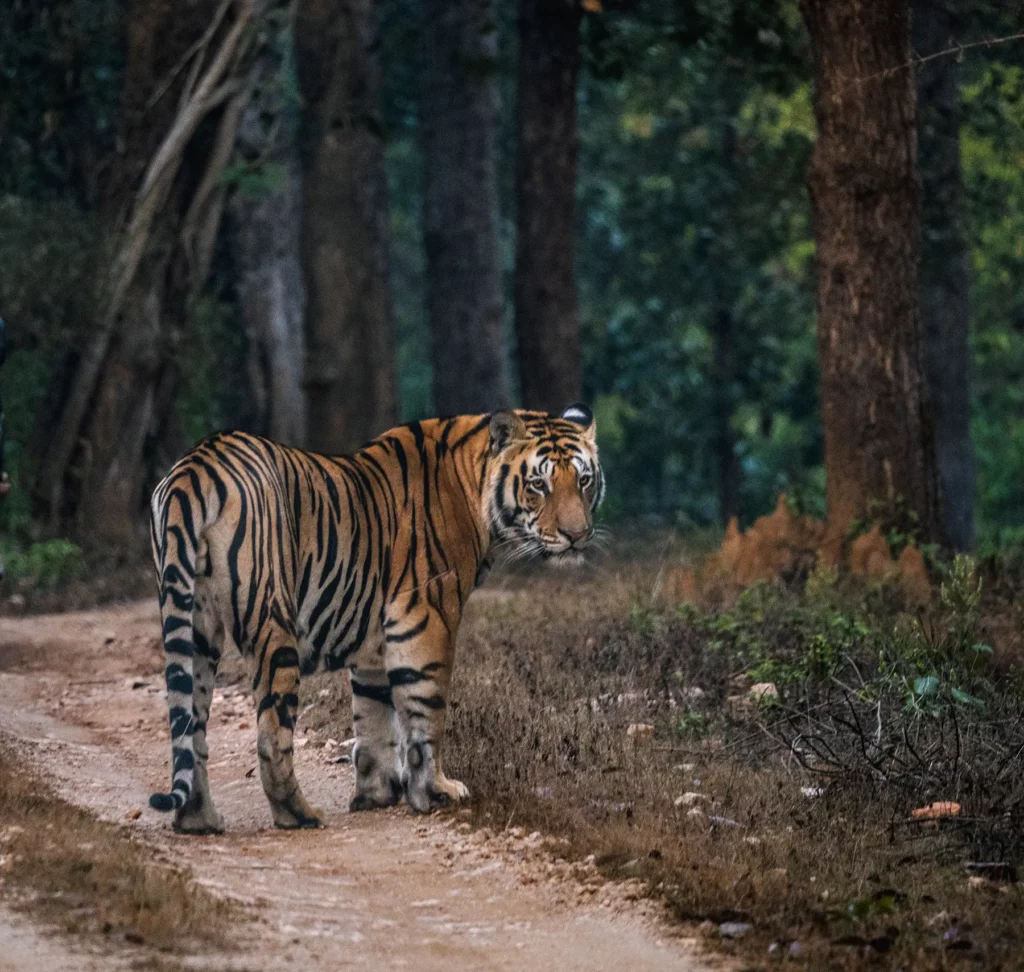
We rounded a corner and suddenly she was there. To my right, just a few metres away from the road, lay a magnificent female Bengal tiger. She was lying in the shade of some bushes, her orange eyes ablaze as they locked with mine. I swear my heart was pounding so loudly that she must have been able to hear it.
We watched each other for some time before at last she stood up, flicked her elegant tail and melted away into the shadows of the jungle.
This sighting turned out to be the first of many on our several day safari through central India. The magic of finding a tiger never faded. In fact with each sighting, my love for the world’s largest cat only increased.
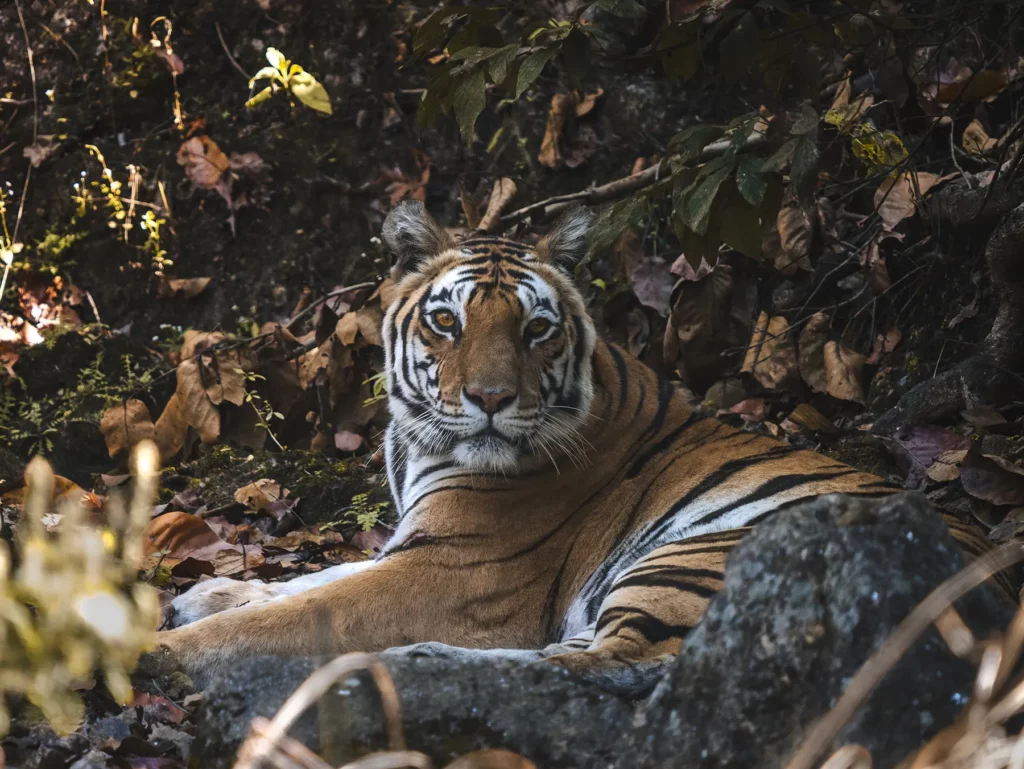
I’m excited to give you all the information you need so that you can experience the same magic. In this article I’m going to dive into everything you need to know about finding wild tigers in India.

Embark on the Safari of Your Dreams
Save time and ensure an incredible safari experience by getting quotes from my recommended local safari companies
I’m here to make booking your perfect safari quick, easy and risk-free.
Join the rapidly growing tribe of over 1,000 travellers who’ve booked their dream safari using my insider tips and recommendations.
It takes under 60 seconds to fill out the form and in under 48 hours you will receive multiple, no-obligation proposals from my favourite local tour operators with glowing online reviews.
Get your free no-obligation safari quotes and my top safari tips and recommendations
In This Guide
- Why See Bengal Tigers in the Wild?
- Where To See Tigers in the Wild
- Why Go On A Tiger Safari In India?
- Best Places to See Tigers in India
- How Much Does An India Tiger Safari Cost?
- Best Time To Visit India for a Tiger Safari
- How Many Days on Tiger Safari?
- How To Book Your India Tiger Safari
- Special Interest / Unique Safaris
- India Tiger Safari Safety
- India Tiger Safari Logistics
- Best India Tiger Safari Itineraries
- Final Thoughts
Why See Bengal Tigers in the Wild?
Tigers are perhaps one of the most beautiful animals on the planet. They possess a raw power to them. They’re incredibly beautiful apex predators and are the largest species of big cat in the world.
Aside from being enigmatic and truly majestic creatures, Bengal tigers are one of the most threatened animal species on our planet. Therefore seeing one in the wild feels like a truly special and unique experience.
Visiting them in the wild not only leaves us with amazing memories but also helps to conserve them. I’ll dig deeper into this below.
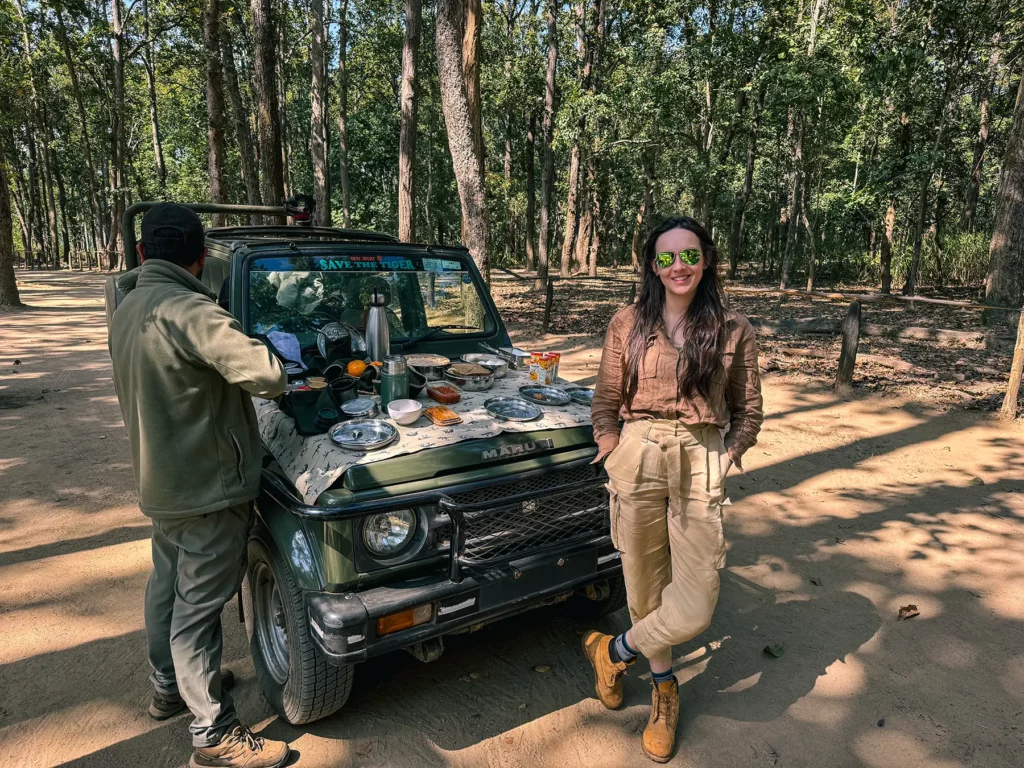
How Many Tigers Are Left?
Although it’s said that there are only one species of tigers left in the world, they are divided into several subspecies, with the last six remaining being the Amur or Siberian tiger, Sumatran, Amoy or South China tiger, Malayan, Indo-Chinese, and of course the mighty Bengal or Indian tiger. The Bengal tiger is the most common subspecies, and can be found across several countries in Asia mainly India, China, Bangladesh, Bhutan and Nepal.
It was thought that over 100,000 tigers once existed across Asia, but relentless hunting, poaching, poisoning and through loss of habitat and urbanisation over the last century or so, numbers plummeted to around 3,000.
Having realised by the 1980s that the species was fast approaching total extinction, a major effort by several governments and conservation bodies, has managed to stem the tide somewhat, and today it is estimated that around 5,500 tigers remain in the wild.
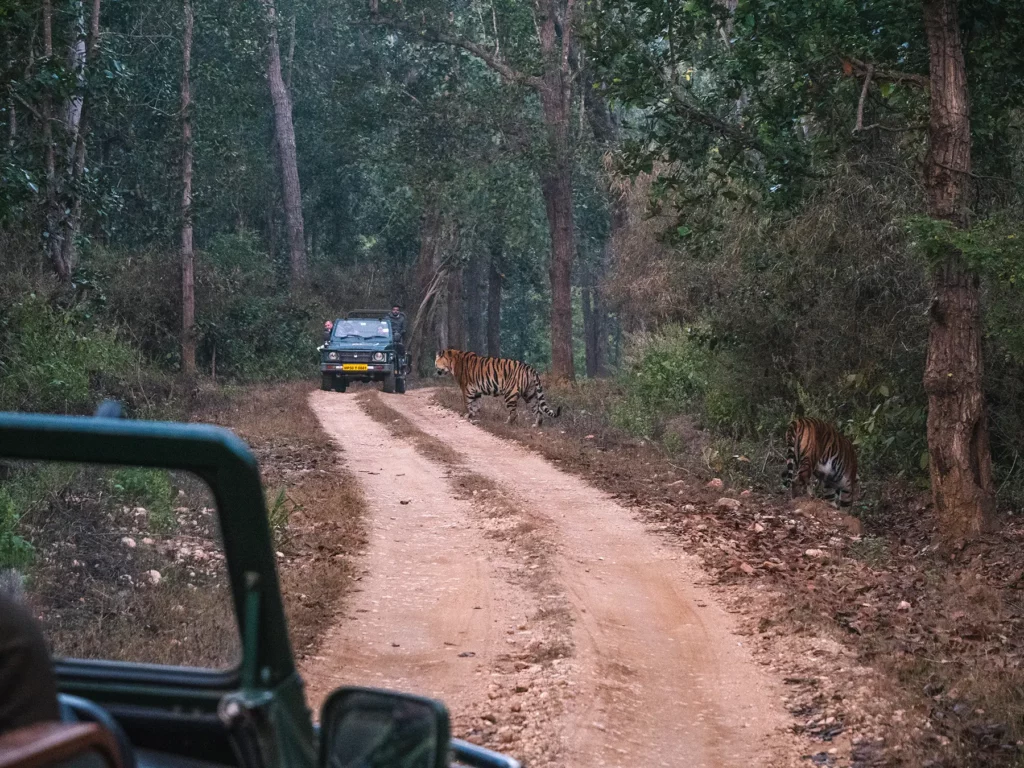
Although exact numbers are sketchy, it’s thought that around 3,500 Bengal tigers live in the wild today, with India being home to 70 – 80% of the total population, and without proper protection, extinction still remains a stark possibility.
There are about 800 Malayan tigers and only 400 Sumatran tigers left in the wild today. There are also only 400 – 500 Siberian tigers left in the wild, all living in Far East Russia and north-eastern China.
Unfortunately some tiger sub-species like the Bali, South China, Caspian and Javan tigers did not survive and they were declared extinct, with the Caspian tiger being as recently as 2003. The Amoy, or South China tiger is believed to be extinct in the wild, with only a few remaining individuals living in captivity in zoos across China. Unreliable sources and anecdotal information do however, suggest that several South China tigers may still be living secretly in the wild.
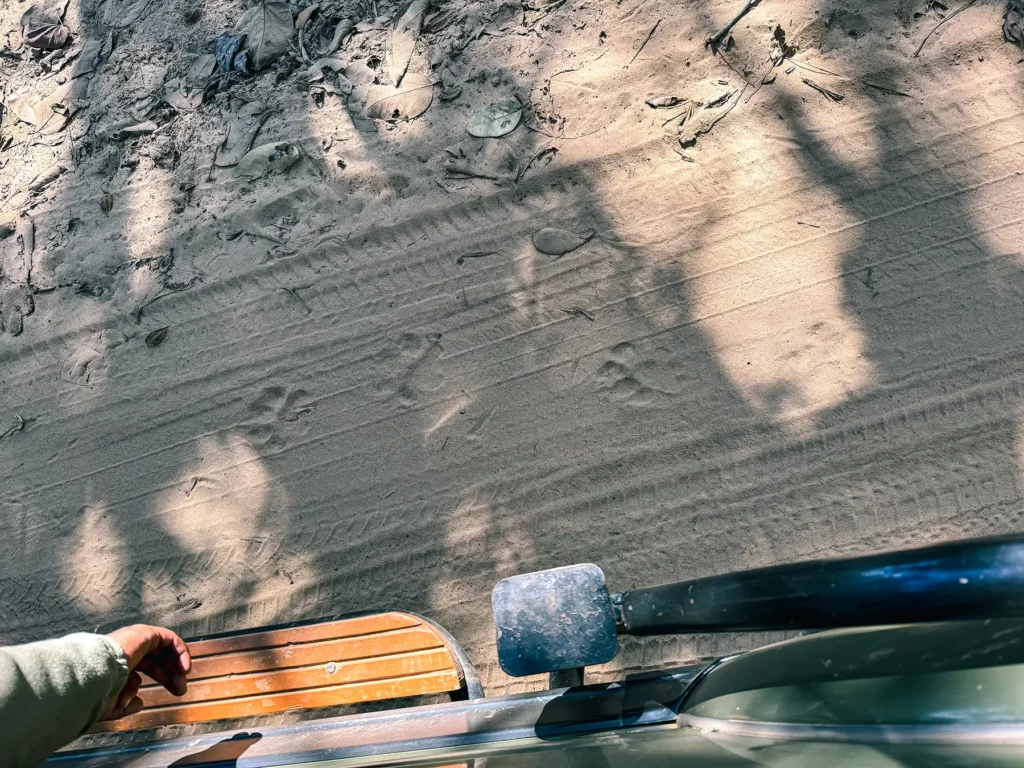
What Threats do Tigers Face?
Although tiger trophy hunting has been banned across Asia and is relatively well monitored and controlled, poaching remains a huge threat to tigers, with virtually every single body part being highly sought-after in the Far East and Middle East. These are used for so-called ‘traditional medicinal’ purposes, claiming that they can cure a wide range of diseases and conditions from cancer, liver disease, malaria, baldness and even keeping you free from evil spirits. Tiger whiskers are believed to cure toothache (I am at a loss of how one would apply it) while rubbing a mixture of tiger brains and oil on your face will cure acne and even laziness. There is zero evidence behind any of this.
With tiger bodies fetching up to $5,000 each on the highly-lucrative black market, eradicating poaching of these magnificent animals is going to be an uphill struggle for many organisations for years to come which is also going to cost an enormous amount of money. Changing the mindset of users of these ‘traditional medicines’ might be an even more difficult task.
Habitat loss is another huge contributing factor to the serious decline of tiger populations across India and with the growing population figures and constant urban and agricultural expansions required, it is going to be a difficult task to create an even balance in which humans and tigers can co-exist.
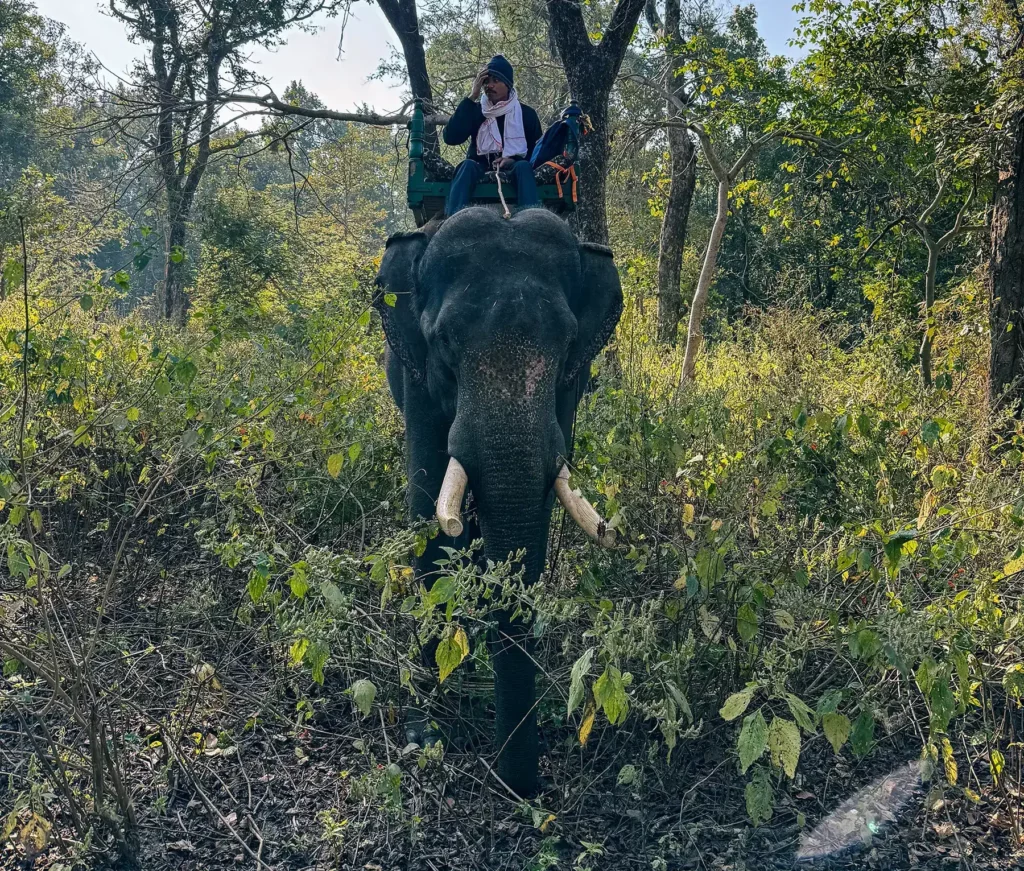
How Do Tiger Reserves Help?
As difficult as that may be, one must commend the Indian Government, which along with several conservation and community groups, has since the 1970s, created no less than 55 tiger reserves in the country. Every single one of these is a success story in their own right.
Not only have these reserves restored the habitat for tigers and other wildlife to thrive in, but they have applied numerous anti-poaching measures, in the form of anti-poaching units carrying out forest patrols and deploying sniffer dogs, cameras as well as forming task units to investigate and prosecute poaching crimes.
The communities also need to play a vital role in the protection of the wildlife and part of the overall conservation program involves raising awareness among the local communities that live among or near tiger reserves. They do that through a number of education initiatives including undertaking wildlife excursions with the local communities, screening of movies and social media campaigns.
By making the communities aware of the benefits of tiger and wildlife protection in the form of job creation through the tourism industry, it helps to reduce human-tiger conflict, which has also contributed hugely to the decimation of tigers over the last century.
Moving away from India, another success story of tiger conservation is being played out in Myanmar, where the Hukaung Valley Tiger Reserve was expanded to 17,477 square kilometres in 2010, making it the world’s largest tiger reserve. Ever since its inception, camera trappings have recorded a growing number of tigers as well as other cat species, including Asian leopards, cloudy leopards, several smaller civet species and even Asian elephants.
Creating wild spaces does not only benefit tigers, but also numerous other animals, birds, insects and flora, which become tourist attractions, in turn benefiting the local communities too.
Although these tiger conservation success stories and many other initiatives across the continent are contributing hugely to the increase in tiger populations, let’s make no mistake about it – there is much work that lies ahead for everyone concerned.

Siberian Tiger vs Bengal Tiger
The tigers in India are all Bengal Tigers. Their cousins the larger Siberian tigers are predominately found in Russia and their smaller relatives, the Sumatran tigers are found in Sumatra, an Island in Indonesia.
Siberian tigers are the largest of all the tiger subspecies with a fully grown male reaching a weight of around 400 kgs. The largest recorded specimen was a 9 year-old in captivity which weighed a whopping 423 kgs.
Bengal tigers are quite a lot smaller generally with a fully grown male averaging around 200 – 250 kgs, which is still heavier than African lions. The largest Bengal tiger ever recorded was a 388 kg male that was shot in 1967, but it was discovered that it had just consumed a buffalo calf.
Sumatran tigers on the other hand, are the smallest of all the subspecies, although a fully grown male can still reach up to 200 kgs in weight.
Siberian tigers also differ from Bengal tigers and although they both have similar coat markings, Siberians have a thicker fur than their tropical cousins, enabling them to survive the harsh and cold climate of their preferred regions.
What they all share is their diet, which consists mainly of deer, wild boar, buffalo as well as smaller prey like monkeys, birds and even small reptiles and fish. They can all consume up to 40 kgs of meat at one sitting, but as only one in twenty hunts produces a kill, they are able to go for several days without eating. A good guess is that tigers make a big kill about once a week.

Interesting Bengal Tiger Facts
Bengal tigers have a broad range of habitat including grasslands, dense forests and being excellent swimmers, rivers, lakes and marshlands too. This allows them to enter water to escape the oppressive heat of the tropics and also pursue any prey that may seek refuge in a lake or river, even in strong currents and turbulent waters. Their yellow and black striped markings provide them the perfect camouflage among the tall grasses, allowing them to stalk their prey getting really close before pouncing on it.
Just like their distant spotted cousins, the leopards, they rely on stealth rather than speed to hunt their prey. Sharing another trait with all cats, is their excellent night vision, using it to maximum effect and allowing them to do most of their hunting after dark.
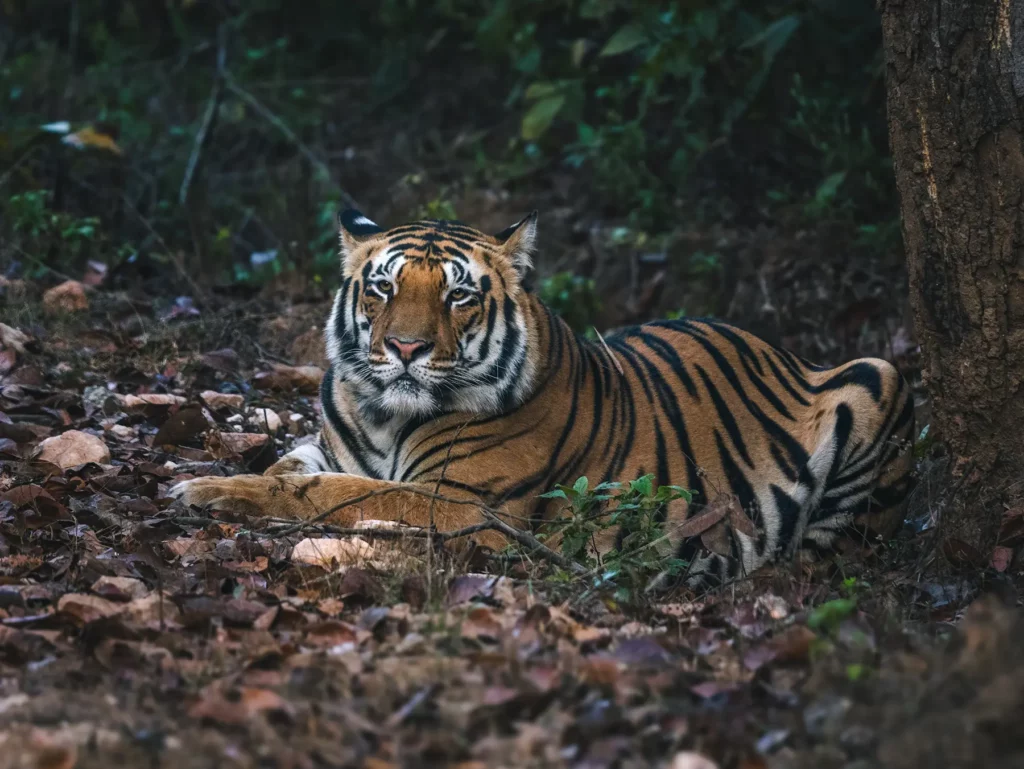
Are Tigers Dangerous?
Thankfully, like most other big cats in the wild, tigers do not see humans as a source of food.
They prefer to avoid human contact as far as possible and things typically only become dangerous when a tiger is threatened by humans. Forced to defend themselves, this is when they can attack.
The only other dangerous tiger is one that is sick and cannot hunt.
According to statistics about 85 people are killed in India by tigers each year. Almost all killings were sparked off by the tiger being threatened in one way or another and not because it was hunting for food. None of the victims‘ bodies were ever taken away to be eaten but were found where the attack took place.
Tigers behave very differently when they encounter a human on foot vs in a vehicle. They have grown accustomed to vehicles and so often don’t even bat an eyelid at them. A human on foot, however, may cause them to flee in fear.
Tiger’s only known fear (other than people on foot) is fire. Tigers seen jumping through rings of fire in circuses do it only for fear of punishment rather than their lack of fear of fire, as the ring masters would have us believe.
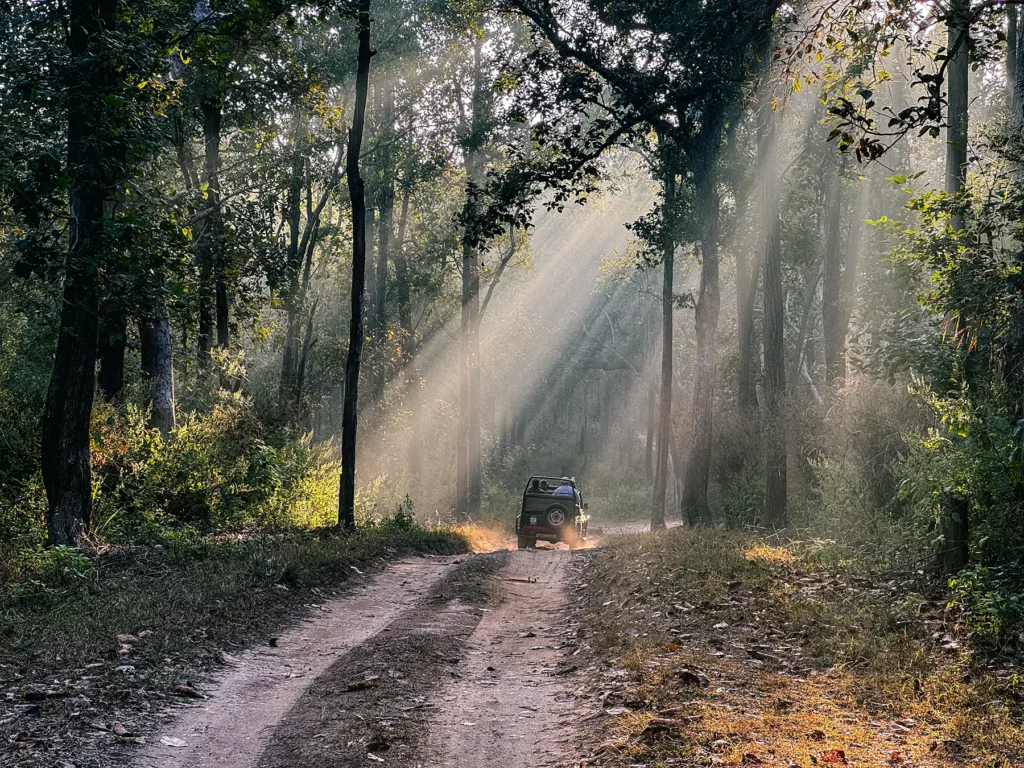
Where To See Tigers in the Wild
With India having 70-80% of the total global tiger population, it is by far the most likely country in the world to see tigers in the wild.
They are however found in other Asian countries, although in lesser numbers.
India has no less than 55 tiger reserves which provide the best opportunity to see tigers and various other wildlife in the wild.
Moving briefly away from India, the tiny Himalayan country of Bhutan, is home to over 100 tigers which are shared amongst several national parks. These include the Royal Manas, Jigme Singye Wangchuck, and the Jigme Dorji National Park, in which Bengal tigers share their habitat with various other wildlife. These include Indian leopards, snow leopards, cloudy leopards, Himalayan black bears, cute and cuddly red pandas and several deer species. In this park a Bengal tiger was once spotted at an altitude of over 4,200 metres above sea level, making that the highest elevation of a tiger ever recorded.
Between 300 and 400 tigers are shared among three of neighbouring Nepal’s national parks. They are Parsa, Chitwan and Bardiya National Parks which also offer sanctuary to a variety of other wildlife such as Indian rhinos, Indian and cloudy leopards, striped hyenas, sloth bears, crocodiles and countless species of deer and birds.
The Sundarbans National Park situated on the Ganges Delta on the India Bangladesh border, is known for its tiger and leopard population. The dense mangrove marshlands and tidal waterways do however make the spotting of tigers quite difficult, but nevertheless it is a spectacular park.
To see Siberian tigers in the wild, one would have to travel to Far East Russia and north-east China. The Zov Tigra National Park, situated 100 kms northeast of Vladivostok, was established in part for the recovery of the Siberian Tiger but its remoteness and ruggedness makes the possibility of seeing a tiger an extremely rare event. Perhaps its remoteness and ruggedness provide them their best form of protection from humans.
There are of course numerous places across Asia and Indonesia, where tigers in captivity or in small reserves can also be seen.
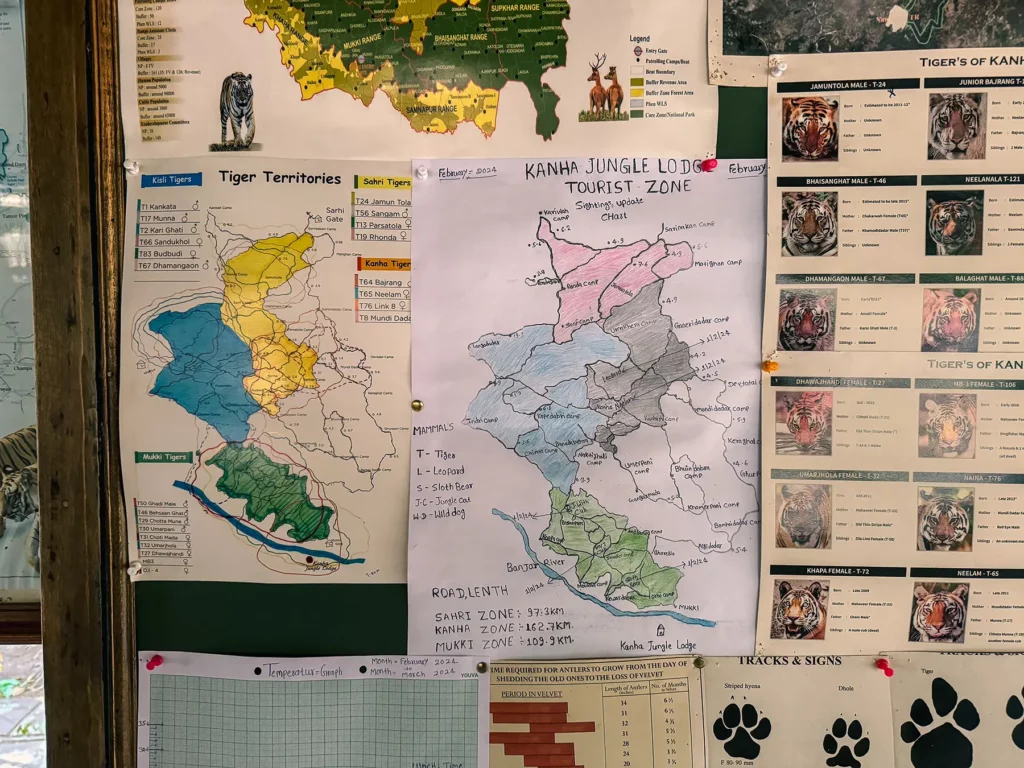
Places to Avoid
Whilst it can be tempting to guarantee your chances of seeing a tiger and have a hands-on experience with these majestic creatures at a zoo or ‘sanctuary’ (many places market themselves as sanctuaries but are actually just zoos), these establishments are often extremely unethical, keeping tigers in terrible conditions and oftentimes breeding them for their use in Chinese medicine.
The Siberian Tiger Park, situated in the heart of the city of Harbin in northeast China, claims to be the largest breeding ground of Siberian tigers in the world. Although that part may be true, they also claim that their main aim is to breed endangered animal species for the purpose of introducing them in the wild and help to restock reserves across the country. I have some serious doubts about this claim.
The entire so-called reserve is less than 2 square kilometres in size and all animals are kept in small enclosures and cages and are not free to roam in a natural habitat to prepare them for rewilding.
Furthermore, it is even more disturbing to see visitors buying live animals to feed these cats and watching them tearing them to pieces. Chickens, goats and even cows are lowered into the enclosures for hungry groups of tigers to attack, dismember and devour, while onlookers cheer with delight.
I fail to see how that can ever prepare a wild animal to be reintroduced to the wild and still be able to hunt and fend for itself. Releasing a captive-bred tiger into the wild is a big feat and to prepare them, they would need to live as natural a life as possible beforehand, not in a concrete cube and not thrown easy meals that have no chance to escape.
I stand to be corrected, but I seriously doubt whether a single Siberian tiger from here has ever been set free in any tiger reserve. Unfortunately the most likely scenario is that they are being bred for use in ‘traditional medicine’. Captive-breeding tigers for this purpose is sadly commonplace at ‘zoos’ across Asia.
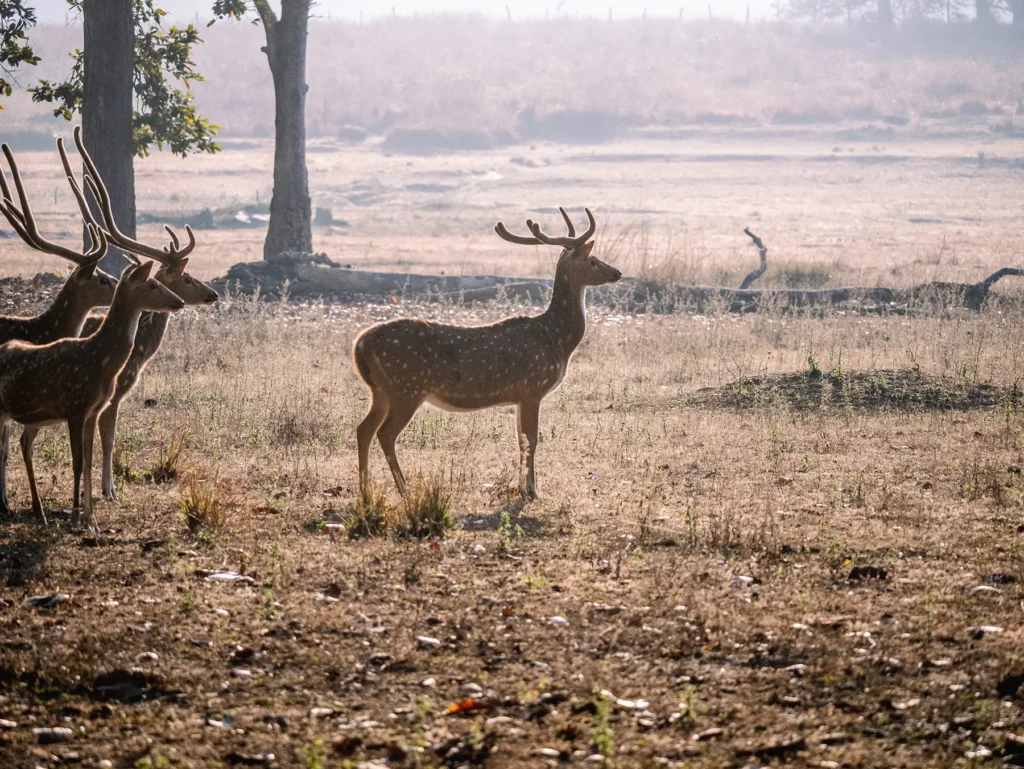
Why Go On A Tiger Safari In India?
With numbers of tigers in India continually being on the increase, surveys carried out every four years are vital in enabling the authorities to monitor their progress and plan accordingly. The latest Tiger Census Report that was carried out in 2022 showed the total count of tigers had risen to 3,682, a whopping increase of 715 from the previous survey of 2018.
These figures make India the country with the highest tiger population in the world, so it isn’t difficult to see why going on a tiger safari in one of the 55 tiger reserves in India makes sense.
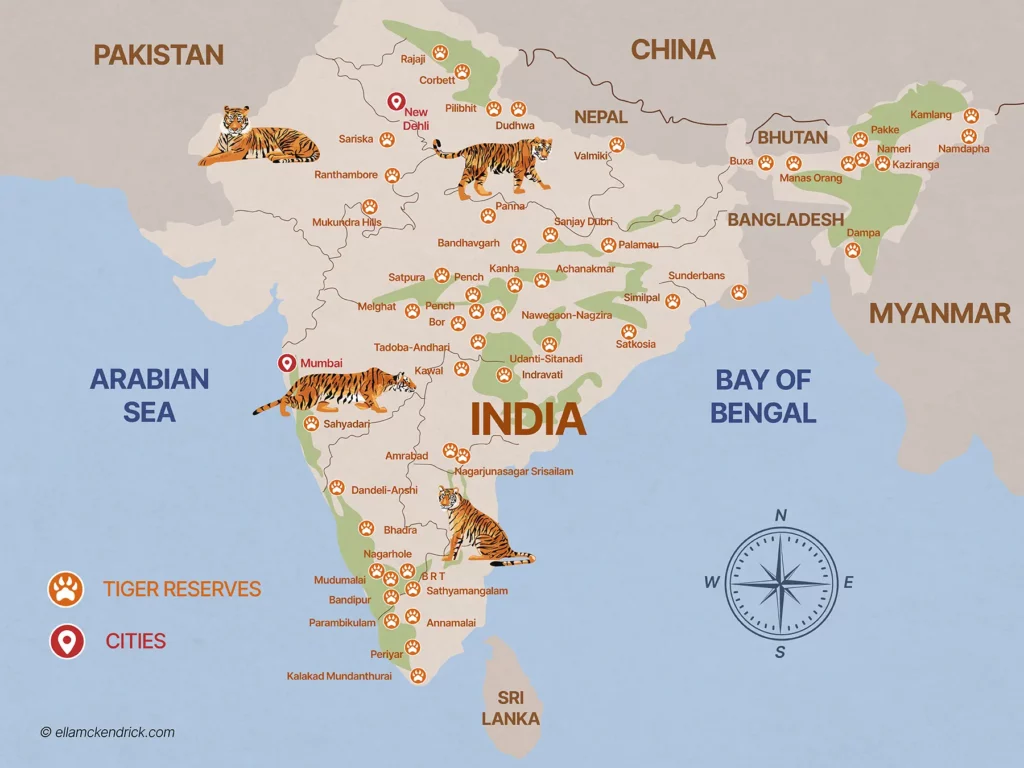
These tiger reserves are spread across India with some being conveniently located in close proximity to the big cities, while others are tucked away in some remote corner of the country and are not easy to get to. They all vary in total area size, type of terrain as well as variety and density of wildlife, all being vital factors in assessing the chances of actually seeing tigers on safaris.
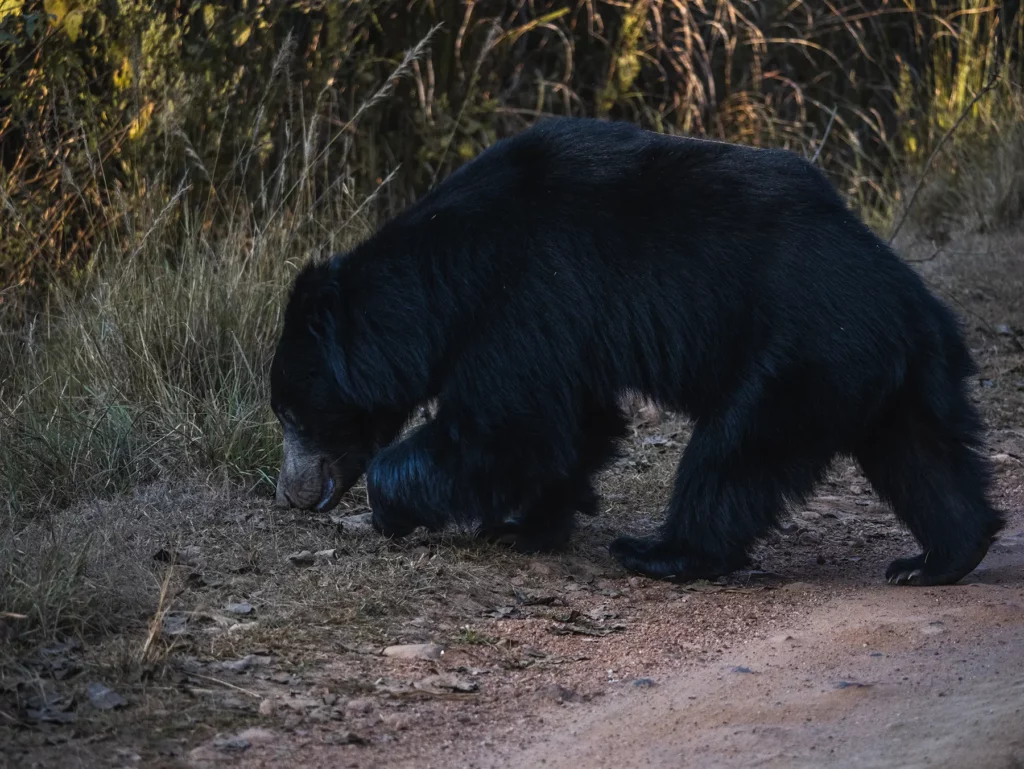
Best Places to See Tigers in India
Housing 55 separate tiger reserves, there’s certainly a lot of choice when it comes to deciding where to go for your Indian tiger safari. However, not all reserves are created equal and some have a higher population of tigers than others. There are some reserves where your chances of seeing a wild tiger are high and others where they are almost zero.
To make your life easier, in this article I have crafted a list of the top 10 best places you’re likely to see tigers in India.

1. Ranthambore Tiger Reserve
Ranthambore Tiger Reserve, situated in the state of Rajasthan in north-western India, is one of the most visited parks in the country and is particularly known for its frequent Bengal tiger sightings.
The park itself covers an area of approximately 151 square miles (392 km²), which forms part of the massive 519 square mile (1,344 km²) reserve.
Its varied landscape of open grasslands, dense forests and numerous lakes, interspersed with rolling hills and valleys, provides the perfect habitat for tigers and a wide range of other wildlife.
Among the other 40 or so species of animals found here, are leopards, striped hyenas, sloth bears, civets, jackals, crocodiles as well as various deer species and wild boar, which are the staple diet for tigers. Ranthambore is also home to over 300 species of birds, including snake eagles and a number of well-known snake species like Indian pythons and cobras.
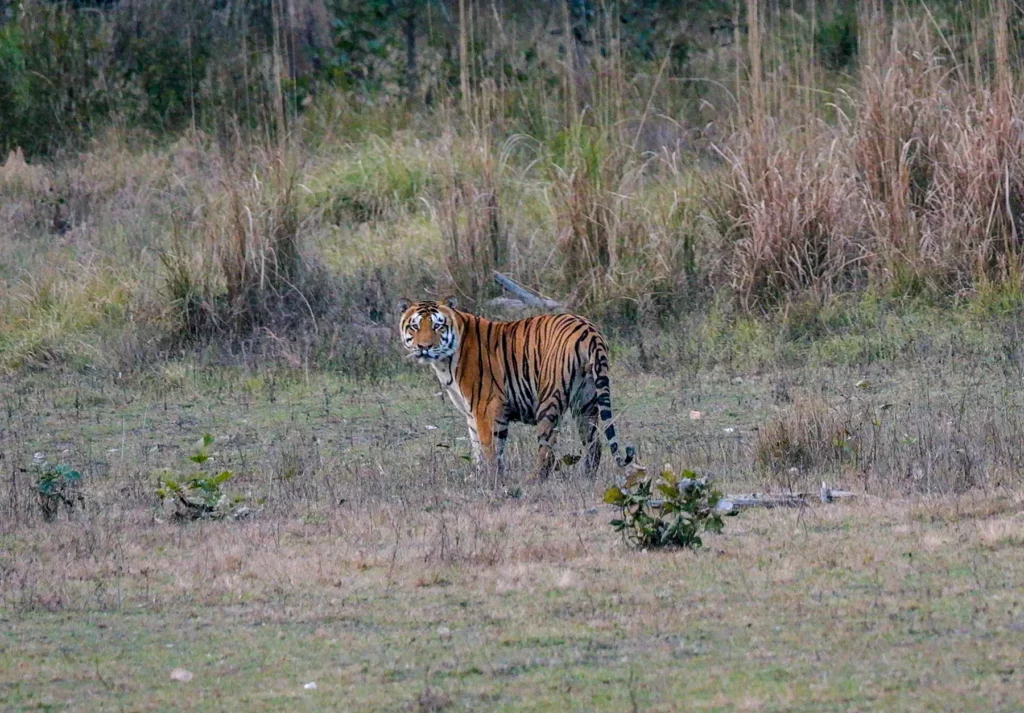
The park is divided into different zones, each with its own tiger population, and it’s always best to enquire which one would provide you the best chance of seeing tigers when setting off on safari.
Within the park, there are several historical and cultural attractions other than the wildlife that are worth visiting. These include the 8th century Ranthambore Fort, from where spectacular views of the park can be enjoyed and other various temples and ancient ruins.
Ranthambore Quick Facts
Nearest City: Jaipur. The 81-mile (130 km) trip takes 3 hours 20 minutes on the NE4 Highway. It is also 8 miles (13 km) from the small city of Sawai Madhopur.
Nearest Airport: Jaipur International Airport. 3 hours 20 minutes on the NE4 Highway
Estimated Number of Tigers: 80
Chance of Seeing a Tiger: Very high
Recommended Number of Safaris to see a Tiger: 2 safaris should be enough to encounter a tiger. You can do 2 safaris per day which take place in the mornings and late afternoons as these are the best times to spot a tiger. Animals tend to hide in the dense bush in the afternoons to escape the midday heat, coming out again after 6 pm. However, to increase your chances of seeing tigers substantially, a 2 nights’ stay (4 safaris) is recommended.
Best Zones to See a Tiger: Zones 1 – 6 which form the core of the park. Zone 2 may be the best of them all, due to the many watering holes being in the area. Zone 3 is also very good as it contains Ranthambore’s most famous lakes – it is arguably the most scenic zone.
Best Time to Visit: During the cooler months between October and June. Some zones close during the monsoon season (July-September).
Entry Cost: $300 USD per person for a private safari in a core zone in a Gypsy (jeep) with a tracker and driver.
2. Jim Corbett Tiger Reserve
Situated in northern India beneath the foothills of the Himalayas, Jim Corbett Tiger Reserve is one of the most prestigious and oldest tiger sanctuaries in the country.
The entire reserve covers an area of 509 square miles (1,319 km²) although the main park area is an impressive 200 square miles (520 km²) area, which holds the densest population of tigers in India.
Although Bengal tigers are the stars of the show, there are also 600 elephants, black bears, sloth bears, wild boar, spotted deer, otters, crocodiles, monkeys and king cobras. Amongst the over 600 species of birds, you’ll find fish eagles, pied hornbills, white-backed vultures and tawny fish owls.
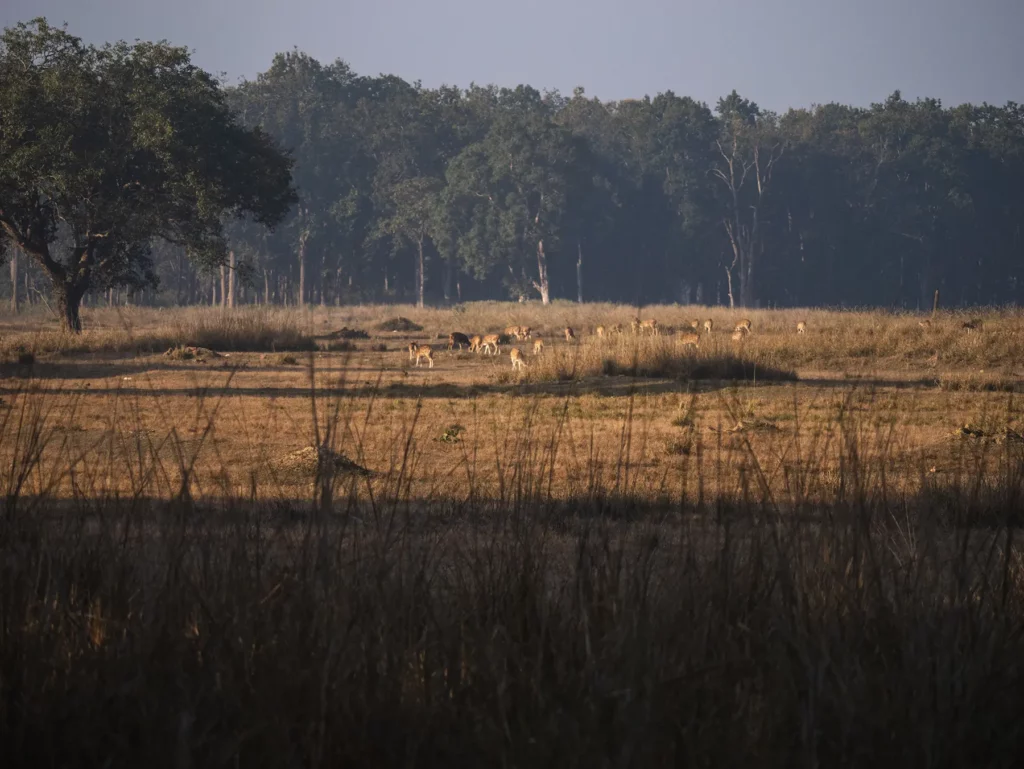
Numerous high-end and budget-friendly lodges are available both inside and outside the park, most of which can arrange a wide variety of safari adventures. Over and above the normal jeep safaris, one could also embark on a birding safari.
Additional activities include excellent fishing along the several rivers that flow through the park. Targeted species include the massive Goonch (a type of catfish), Indian trout and the Golden Mahseer, which can reach up to 2.75 metres in length.
Jim Corbett Quick Facts
Nearest City: New Delhi. The 155-mile (250 km) road trip to the reserve takes approximately 5 hours.
Nearest Airport: Indira Gandhi International Airport, New Delhi. 5½ Hours’ drive to Jim Corbett, depending on choice of gate.
Estimated Number of Tigers: 260
Chance of Seeing a Tiger: Very high
Recommended Number of Safaris to see a Tiger: 4 safaris over 2 days.
Best Zones to See a Tiger: Bijrani Zone. The scenic open grasslands make spotting of tiger and other wildlife easier and is only one kilometre from the gate. Dhikala Zone is also extremely popular as it is the largest and one of the most beautiful and diverse zones in landscape, density and variety of animals including tigers.
Best Time to Visit: Winter months between October and February. Weather is pleasant during the days with mild temperatures, dropping to a cool 5°C at night. It is also an excellent period for birders.
Entry Cost: $200 USD per person for a private safari in a core zone in a Gypsy (jeep) with a tracker and driver.
3. Kanha Tiger Reserve
Situated in the two districts of Mandla and Balaghat in Central India, the core of Kanha National Park covers an area of 363 square miles (940 km²), which forms part of the overall 801 square mile (2,074 km²) tiger reserve.
This huge landscape consists of scenic grassy meadows and lush forests of bamboo, shrubs and trees, with crystal clear streams flowing through, providing ideal habitats for a wide variety of wildlife, aside from its rich population of tigers.
These include leopards, wild dogs, jackals, wild boar, sloth bears, several primates and thousands of deer, including the endangered, rare and regal-looking swamp deer known as the Barasingha, which Kanha is solely responsible for bringing back from the edge of extinction.
Kanha is also home to 320 species of bird and numerous snakes including Indian pythons and the highly venomous Russell’s viper, Common Krait and Indian cobras.
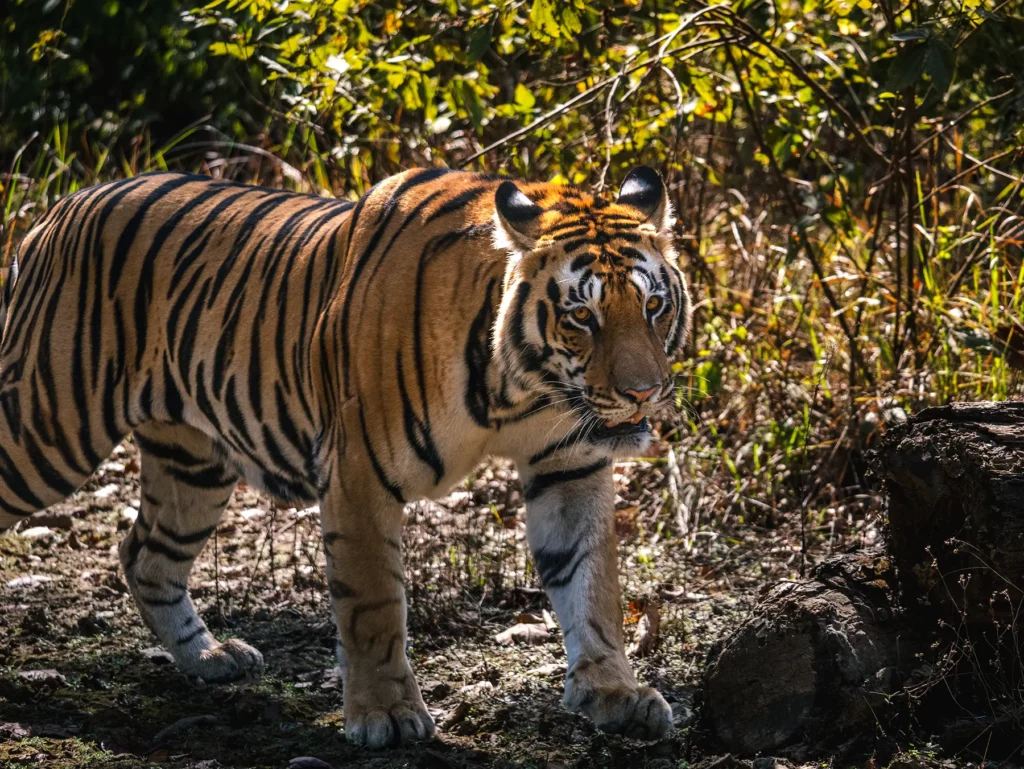
Morning safaris provide a better chance of seeing tigers as they tend to hide in the thick bush during midday and afternoons, venturing out again in the evenings when it cools down.
Unlike Ranthambore and Jim Corbett, Kanha offers full-day safaris, although permits are extremely limited (5 per day) and come at more than double the cost of doing 2 safaris in one day.
The huge advantage of being on safari during midday, is that most vehicles have also left, allowing you to view the wildlife in peace and quiet. The tigers are much more likely to wander down the roads at this time of day, knowing they are quiet, and so you can have some mesmerising sightings.
Full day safaris also allow you to enter the park before and after everyone else, allowing you even more time to search for tigers.
Along with Pench National Park, Kanha is the park that provided English writer Rudyard Kipling the inspiration to create his famous ‘Jungle Book’.
Kanha Quick Facts
Nearest City: Jabalpur – About 4 hours’ drive to the park.
Nearest Airport: Dumna Airport, Jabalpur, is 99 miles (160 km) away, and a trip to the park from there can take 4 hours.
Estimated Number of Tigers: 50
Chance of Seeing a Tiger: High
Recommended Number of Safaris to see a Tiger: 6 safaris, (2 x safaris per day across 3 days) or 2 full days.
Best Zones to See a Tiger: Kanha, Kisli and Mukki zones are the park’s core zones and each house a number of tigers. Which is best ultimately depends on recent tiger activity. For example, a zone where there are currently tiger cubs would be preferable.
Best Time to Visit: Best in the winter months between October and March. Days are sunny and pleasant but night time temperatures often plummet to below freezing. Warm clothing is recommended on morning game drives. Winter is a good time for birders too as many migratory species visit the park. The park shuts down during the monsoon season (Mid-June to September) which receives an average of 1,800 mm of rain.
Entry Cost: $200 per person for a private safari in a core zone in a Gypsy (jeep) with a tracker and driver.
4. Bandhavgarh Tiger Reserve
Situated in the Vindhya Hills in the Umaria District in Central India, Bandhavgarh has one of the highest tiger population densities among all parks in India.
Once the hunting grounds of the Maharaja of Rewa, today it’s one of the most significant tiger breeding reserves in the country. The reserve encompasses a total area of 593 square miles (1,537 km²), with the core areas where most tigers live being just less than half of that.
The reserve’s landscape is a rich blend of grasslands, forests and swamps, making it an ideal habitat for tigers and its prey to thrive in.
Apart from a high population of tigers, the park is teeming with a wide range of other wildlife such as leopards, wild dogs, Indian wolves, jackals, wild boars, sloth bears, gaur (Indian buffalos) and various deer including the petite spotted deer, sambar and the nilgai, which is the largest antelope in Asia.

The park’s rich diversity includes over 300 species of birds and numerous snake and reptile species too. It is also home to numerous rare species including the fearless honey badger, also known as a ratel, rusty spotted cats, fishing cats, Malabar pied hornbills and flying squirrels, which ‘fly’ from tree to tree and can parachute to the ground from dizzy heights.
Due to its popularity, the park gets pretty booked up during high season and it’s wise to book online well in advance. The park closes during the monsoon months of July to mid-October.
Apart from the scenic beauty and abundant wildlife, there are numerous attractions of historical, cultural and archaeological interest, such as the statue of Lord Vishnu, the Bari Gupha, a massive man-made cave dating back over 1,000 years and the Rampur Hillock, which provides panoramic views of the entire park and surrounds.
Like Kanha, Bandhavgarh also offers full-day safaris which give you the unique opportunity to be within the reserve from dawn to dusk, with many hours in the middle of the day with few cars around.
Bandhavgarh Quick Facts
Nearest City: Umaria is the closest at 20 miles (32 km). It’s a 30 minutes’ drive to the park.
Nearest Airport: Jabalpur Domestic Airport is 106 miles (170 km) away, and it takes 4 hours by road. The nearest international airport is Nagpur, 286 miles (460 km) away, taking 9 hours to Bandhavgarh by road.
Estimated Number of Tigers: 135
Chance of Seeing a Tiger: Very high
Recommended Number of Safaris to see a Tiger: Minimum of 2 days giving you 4 safaris.
Best Zones to See a Tiger: The 3 core zones of Tala, Maghadi and Khitauli.
Best Time to Visit: As with most parks in India, October to March.
Entry Cost: $200 per person for a private safari in a core zone in a Gypsy (jeep) with a tracker and driver.
5. Tadoba Tiger Reserve
Situated in the Chandrapur district of Maharashtra State in Central India, Tadoba Tiger Reserve encompasses an area of 667 square miles (1,727 km²), which includes the Tadoba National Park.
The landscape has a rich blend of lush grassy meadows, dense forests mainly of teak, and many hills with a river and a few lakes, all providing an ideal habitat for many of its residents.
Apart from the tigers, there are also leopards, wild dogs, bears, Indian buffalos (gaur), striped hyenas, small Indian civets, marsh crocodiles and several deer species, which provide the main food source for the tigers.
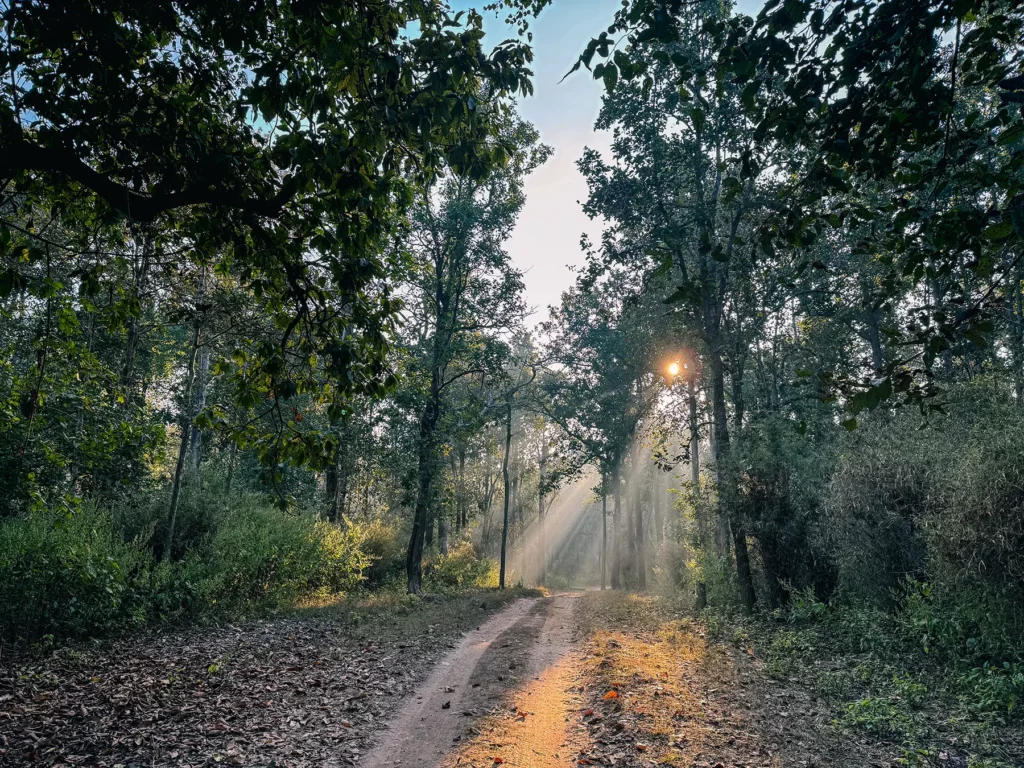
Tadoba is also a bird haven having nearly 200 species of bird including migrants and several endangered species and birds of prey like the grey-headed fish eagle and crested serpent eagle. Talking of serpents, all the usual suspects like Russell’s vipers, cobras and pythons thrive here too.
Many people live and farm around the reserve and their cattle are often found wandering in the buffer zone of the reserve and are sometimes killed by tigers, leopards and sloth bears.
Quick Facts
Nearest City: Nagpur is 93 miles (150 km) away. It takes about 2 hours 15 minutes by road to the reserve.
Nearest Airport: Nagpur International Airport is a 2 hours’ drive to the reserve.
Estimated Number of Tigers: Around 60
Chance of Seeing a Tiger: Medium
Recommended Number of Safaris to see a Tiger: At least 6 safaris over 3 days
Best Zones to See a Tiger: Moharli and Tadoba zones are best. Kolsa zone is mainly made up of dense forest vegetation and although it holds a healthy tiger population, they are not easily spotted.
Best Time to Visit: October to March. October and November provide breathtaking scenery with the landscape being lush and green from the earlier wet season, but dense vegetation may hinder spotting of animals.
Entry Cost: $200 per person for a private safari in a core zone in a Gypsy (jeep) with a tracker and driver.
6. Sundarbans National Park
Situated in the far eastern corner of India, much of the Sundarbans National Park area is shared with neighbouring Bangladesh, and it’s the only mangrove forest and tiger reserve in the world. It also boasts of being one of the few reserves in the world where tigers co-exist naturally with the greater one-horned rhinoceros.
The reserve stretches across one of the largest river deltas in the world, covering a massive area of 998 square miles (2,585 km²).
It encompasses numerous islands, villages, mangrove forests, rivers, creeks, mudflats and hundreds of intricate tidal waterways, which pour into the Bengal Basin and upon which boating safaris take place. No jeep safaris are possible here, making Sundarbans a most unique tiger reserve.
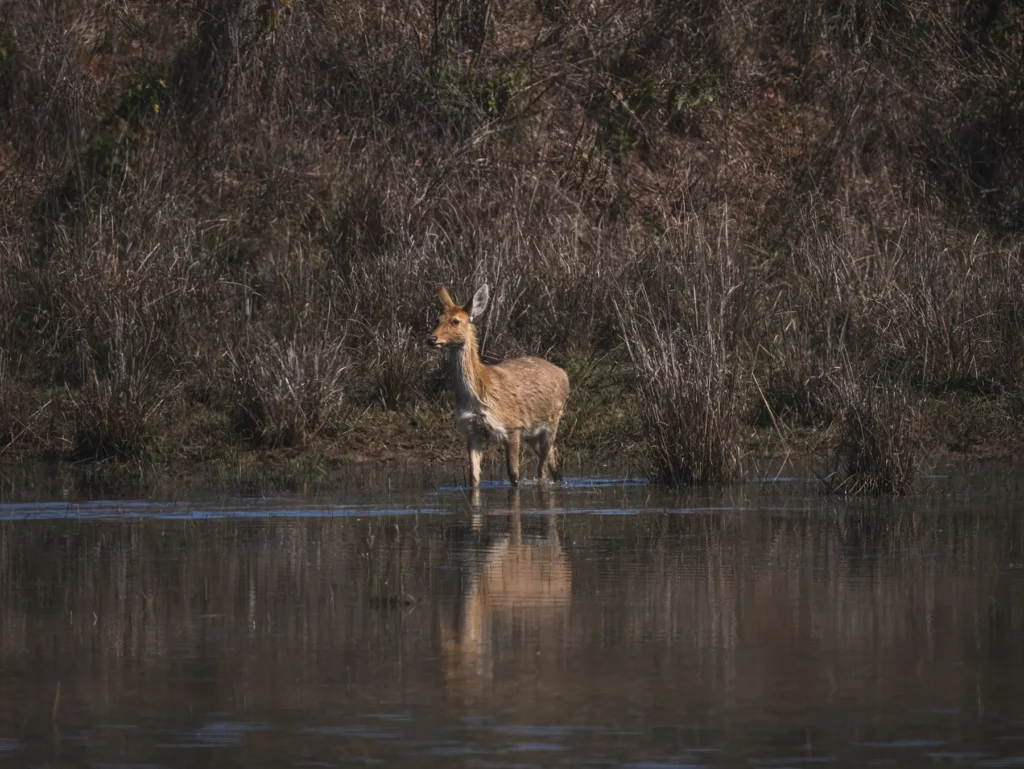
Apart from seeing tigers sunbathing along the shorelines or swimming in the shallow creeks, you may come across leopards and other smaller cats, rhinoceros, wild boar, deer, salt-water crocodiles, marine turtles and Ganges River dolphins.
With so many people living around the park, wildlife-human conflict has been high with over 1,000 people having been killed by tigers here over the last four decades or so. A sobering reminder of how lethal these beautiful cats can be.
The latest census done here in 2022 by Project Tiger, puts the tiger population in the Sundarbans at around 100, making it one of the densest populations among all parks in India.
There are numerous lodges and resorts to stay in and around Sundarbans, but being in such a remote area, there are no ATMs or too many other mod facilities, so ensure you bring enough cash to get by. It is also a no-plastic zone so do not bring any plastic water bottles either.
This totally unique tiger reserve and jewel of India and Bangladesh was declared a UNESCO World Heritage Site in1987.
Sundarbans Quick Facts
Nearest City: Kolkata is 75 miles (120 km) away and can take up to 4 hours to journey by car.
Nearest Airport: Netaji Subhash International Airport Kolkata – 4 hours by road to Sundarbans.
Estimated Number of Tigers: 100
Chance of Seeing a Tiger: Medium
Recommended Number of Safaris to see a Tiger: Considering it is in such a remote area, staying a minimum of 3 days is recommended. This will provide ample opportunities to see tigers in the wild.
Best Zones to See a Tiger: Sundarbans National Park, unlike most other parks in India, is not divided into zones. The guides will use all their local knowledge to take you to places where tigers will most likely be found.
Best Time to Visit: November to March. Weather is great and the temperatures are mild. April to July are okay too, but oppressively hot and humid with the mercury frequently reaching over 43°C.
Entry Cost: $100 per person for a boat safari with a guide.
7. Kaziranga National Park
Tucked away in the far north-eastern corner of India, close to the Bhutan border and along the southern banks of the Brahmaputra River, Kaziranga National Park is a hidden gem like no other tiger reserve in India. It’s home to what is referred to as the ‘Big Five’ of Karazinga – Bengal tiger, Indian rhinoceros, elephant, wild water buffalo and swamp deer.
If that does not provide enough motivation to visit Kaziranga, you can add leopards, sloth bears, golden jackals, Bengal foxes, wild boar as well as smaller and endangered creatures like the Indian and Chinese pangolins. It’s also a recognised bird hotspot and the river waters are home to endangered Ganges River dolphins.
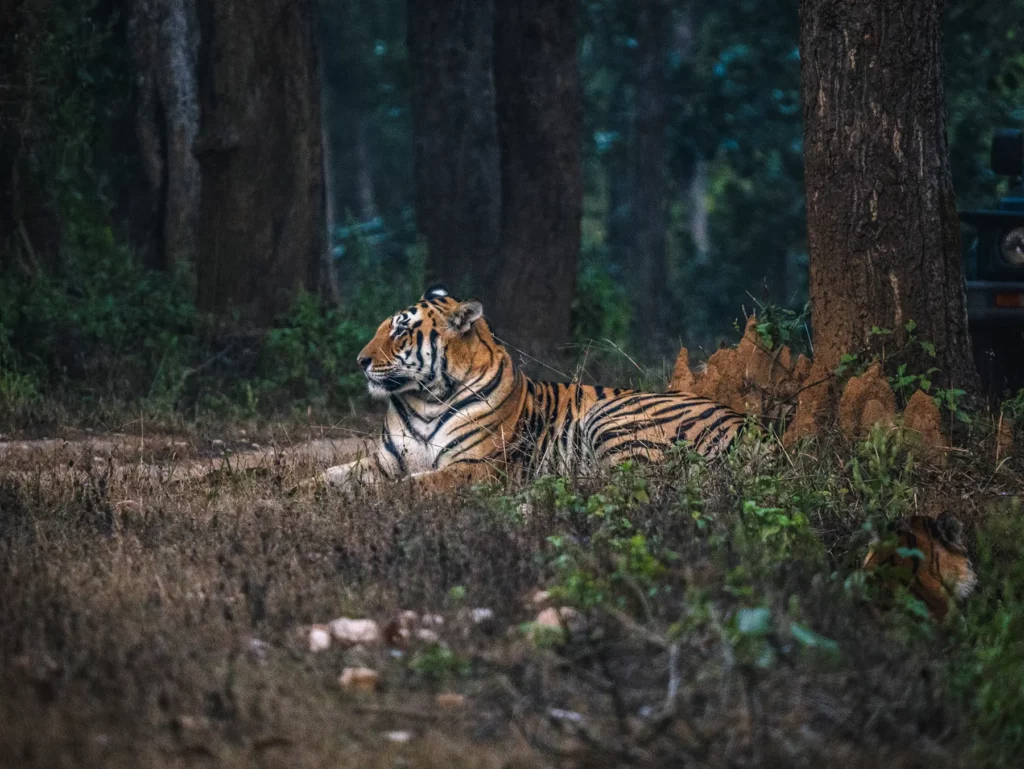
Within this 166 square mile (430 km²) landscape of grassy meadows, dense forests, and swampy lagoons live over 2,000 Indian one-horned rhinoceros, which make up two-thirds of the world’s total population.
Having increased its numbers of tigers substantially, Kaziranga was declared a Tiger Reserve in 2006 after being declared a UNESCO World Heritage Site in1985 for its biodiversity and rhino conservation efforts.
Kaziranga Quick Facts
Nearest City: Guwahati is 127 miles (204 km) from Kaziranga, and the drive takes just over 4 hours.
Nearest Airport: Guwahati International Airport is 4.5 hours by road to Kaziranga.
Estimated Number of Tigers: 135
Chance of Seeing a Tiger: Very high – an average of one tiger per 1.7 square miles (4.3 km²).
Recommended Number of Safaris to see a Tiger: You would most likely need just one day to see a big cat (2 safaris), but considering the distance travelled and the number and variety of other iconic species, I’d recommend spending a minimum of 3 days here.
Best Zones to See a Tiger: Mihimukh region, Bagori, Agaratoli and Ghorakati.
Best Time to Visit: November to February as the weather is stable, comfortable and dry, and the short grasses will make the spotting of animals easier. April and May are also good as the weather is still dry although windy, but animals can be easily spotted around the lakes and river banks. June to September the park closes down due to heavy rainfall and the flooding of the river.
Entry Cost: 100 USD per person for a private safari in a core zone in a Gypsy (jeep) with a tracker and driver.
8. Pench Tiger Reserve
Taking its name from the River Pench that flows through it, Pench Tiger Reserve, along with Kanha, was the inspiration of the Jungle Book by English writer Rudyard Kipling. This is the home of scheming Shere Khan the Bengal tiger, Baloo the friendly sloth bear and all the other lovable characters that continue to entertain our children to this day since 1894.
Situated in Central India, this picturesque reserve covers a total area of 286 square miles (741 km²), which includes 115 square miles (299 km²) taken up by the Pench National Park and the Mowgli Pench Sanctuary.
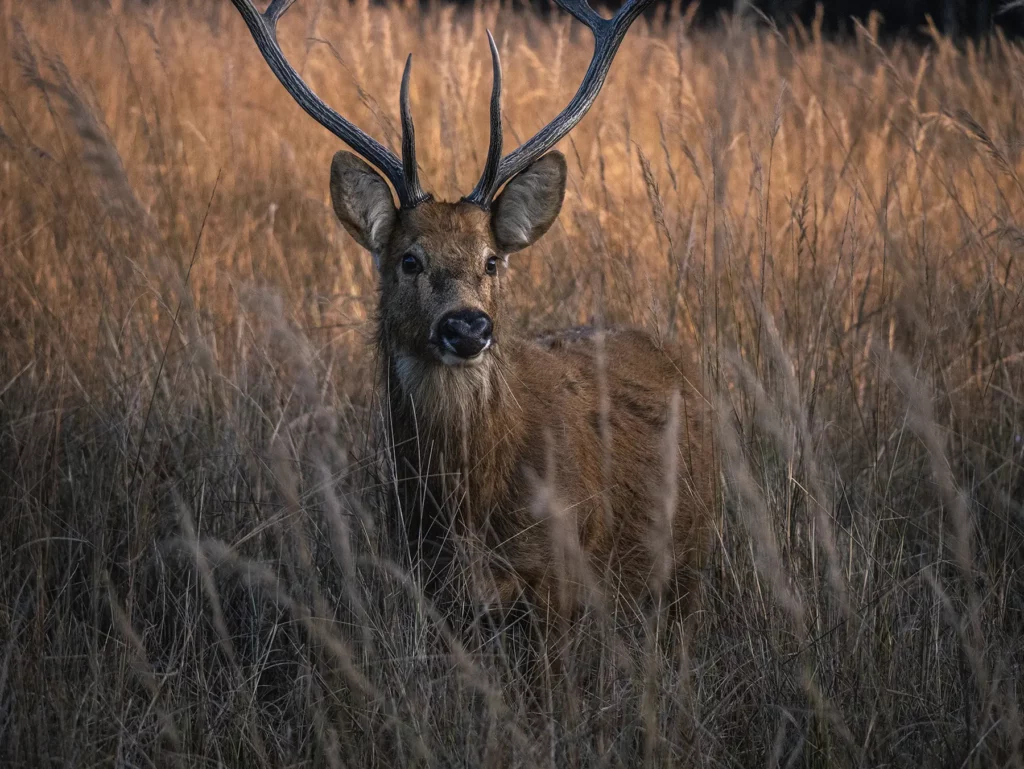
Its convenient location makes it easy to be accessed from Nagpur and other major cities as well as some nearby tiger reserves.
The landscape has a good mix of open plains, sparsely vegetated bushlands and dense forests with lots of water to attract animals.
Apart from the 50 or so tigers, there is a wide variety of other wildlife such as leopards, striped hyenas, jackals, wild dogs, sloth bears, wild boar, gaur, tons of monkeys, various deer and over 300 species of birds.
Pench Quick Facts
Nearest City: Nagpur. It takes 2 Hours to journey to the reserve by road.
Nearest Airport: Nagpur International Airport is 2.5 hours from the reserve by road.
Estimated Number of Tigers: 50
Chance of Seeing a Tiger: Medium
Recommended Number of Safaris to see a Tiger: 6 safaris should be sufficient. Doing 2 safaris per day, would require a 3 night’s stay.
Best Zones to See a Tiger: Pench has seven different zones including just one core zone, which is the best zone to view tigers. The best tiger and leopard sightings can be made near the Turia Gate which is the most popular gate for visitors.
Best Time to Visit: October to February. The core zone is closed during the monsoon season (July-September) but the buffer zones remain open.
Entry Cost: 200 USD per person for a private safari in a Gypsy (jeep) in the core zone with a tracker and driver.
9. Nagarahole Tiger Reserve
Situated in the State of Karnataka in south-western India, Nagarahole Tiger Reserve has a most beautiful landscape, consisting of lush hills and valleys, dense forests rich in teak and rosewood trees, large water reservoirs and swamp areas with numerous rivers and streams with waterfalls winding through the reserve.
This picturesque landscape is brimming with both carnivores and herbivores with a high density of tigers and over 100 leopards. Several reports of black panthers are also received frequently.
Other carnivores include bears and wild dogs. Herbivores include the largest herd of Asian elephants in the world, wild gaurs, wild boars and several deer and antelope species.
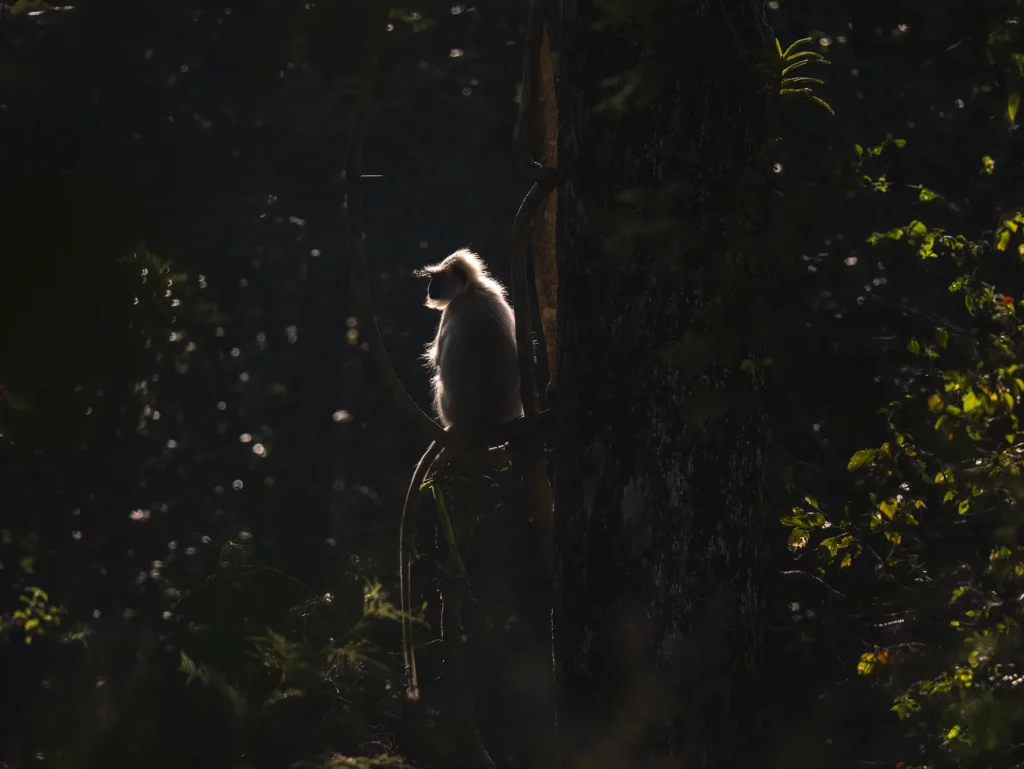
Nagarahole is also a birder’s paradise hosting close to 200 species of birds, including eagles, white-backed vultures, herons and colourful parakeets, among others. Crocodiles and numerous snakes also abound here, mainly around the swamp areas and dense forests in the south-eastern section of the park.
The core area of Nagarahole, which forms the critical tiger habitat, is 248 square miles (643 km²) in size, where you stand the best chance of seeing tigers, with another peripheral area of 217 square miles (562 km²) made up of protected forests and community lands.
Three types of safaris can be experienced in Nagarahole – Jeep safaris, bus safaris and boating safaris. Bus safaris are the cheapest but may not provide the best opportunities to see tigers and other secretive animals due to the noisiness.
Boating safaris are ideal to spot aquatic creatures, like crocodiles as well as a high number of water birds.
Jeep safaris are the most popular mode and provide the best opportunity to see more animals, including tigers and leopards, which are the main stars after all.
When visiting Nagarahole, it may be worth visiting the 3 other adjoining parks and the various cultural and historical landmarks in the area.
Nagarahole Quick Facts
Nearest City: Mysore is the closest city and is around a 1.5 hour drive from Nagarahole.
Nearest Airport: Mysore Domestic Airport is a mere 80 minutes’ drive from Nagarahole. The nearest international airport is in Kannur International Airport which is a 2.5 hour drive from Nagarahole.
Estimated Number of Tigers: 164
Chance of Seeing a Tiger: High
Recommended Number of Safaris to see a Tiger: A 2 day’s stay giving you 4 safaris should give you the opportunity to spot a tiger.
Best Zones to See a Tiger: Core area. This isn’t split into zones.
Best Time to Visit: The winter months of October to May. Temperatures are mild with November to January being the most ideal. Summers are great for bird watchers, but the high temperatures make trekking on safaris very challenging. June to September are out of the question as it is the height of the monsoon season and the forests are teeming with leeches.
Entry Cost: 100 USD per person for a private safari in a Gypsy (jeep) in the core zone with a tracker and driver.
10. Satpura Tiger Reserve
Situated in the State of Madhya Pradesh in Central India, Satpura is one of the largest and most biodiversity-rich reserves in India, and yet remains one of the least visited parks, making it an ideal place to enjoy safaris without being smothered by hordes of jeeps and visitors.
The park covers a massive area of 824 square miles (2,133 km²), consisting of rugged gorges and high mountain peaks, lush hills and deep valleys, dense forests and shrublands, and loads of small rivers with waterfalls, offering a range of habitats for its wildlife residents.
Apart from tigers, you can expect to find leopards, gaur (Indian buffalo or bison), wild dogs, wild boars, sloth bears, crocodiles, and a vast selection of antelope and deer, ranging from the Nilgai, the largest of all Asian antelopes, to the diminutive mouse deer and including the four-horned antelope and protected black buck.
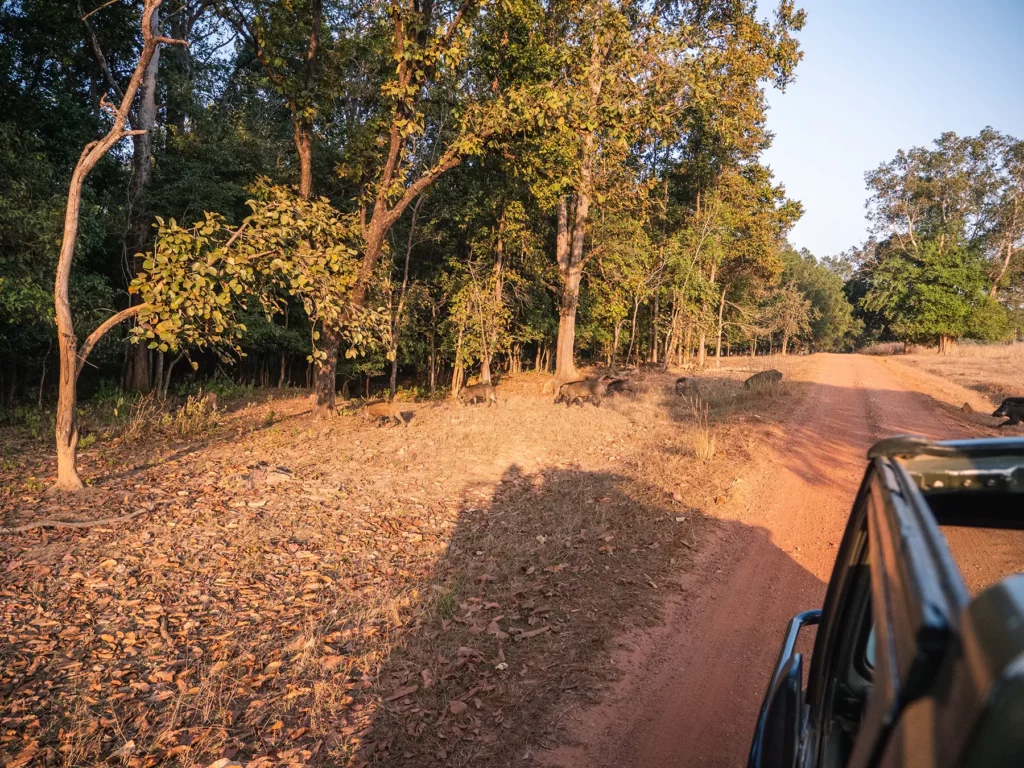
There are also many other smaller and lesser-known species found here in abundance, such as foxes, otters, langur monkeys, porcupines, flying squirrels and critically-endangered pangolins.
The varying terrain is also a haven for a large number of birds from big raptors to hornbills and vivacious peacocks and of course, the most melodious songster of Satpura, the Malabar Whistling Thrush.
The vast and densely vegetated terrain however, makes spotting of tigers more difficult and are not sighted as regularly as in other parks in Central India. In fact, leopard sightings are more frequent than tiger sightings, despite Satpura being hailed as a tiger reserve. Visitors are urged not to set off seeking to view only tigers, but to enjoy the diverse and abundance of all of Satpura’s wildlife, its peacefulness and scenic splendour.
Jeep safaris and canoeing safaris can all be done here and Satpura is the only tiger reserve in India where visitors can enjoy walking safaris in its core zone.
Satpura Quick Facts
Nearest City: Chhindwara is just over one hour away from Satpura.
Nearest Airport: Chhindwara Domestic Airport is just over one hour from Satpura. The nearest international airport is Bhopal International Airport which is 3 to 4 hours away by road.
Estimated Number of Tigers: 50
Chance of Seeing a Tiger: Low
Recommended Number of Safaris to see a Tiger: Due to the vastness and ruggedness of this park, it is recommended that you spend as much time as possible, if you’re really bent on seeing tigers in the wild.
Best Zones to See a Tiger: The Madhai Zone is by far the best, having a mix of hills and meadows with plentiful water sources, all ideal features for tigers to roam in.
Best Time to Visit: October to February, when the weather is pleasant and temperatures hover in the mid-20s°C. The vegetation is mostly dry too, making the spotting of animals easier. Much of the wildlife will usually be found close to water points.
Entry Cost: 200 USD per person for a private safari in a Gypsy (jeep) in a core zone with a tracker and driver.
How Much Does An India Tiger Safari Cost?
For a private Indian tiger safari to core zones with everything included (accommodation, all meals, airport transfers, permit etc) you can expect to pay around $500 per person per day. This price assumes you are a group of 2 people and costs can increase by up to 60% if you are a solo traveller.
The costs of an Indian tiger safari at first glance may seem quite high, certainly if you compare them with the costs of an African safari in Tanzania or Kenya where prices start at $300 per person per day. However, there are reasons behind this.
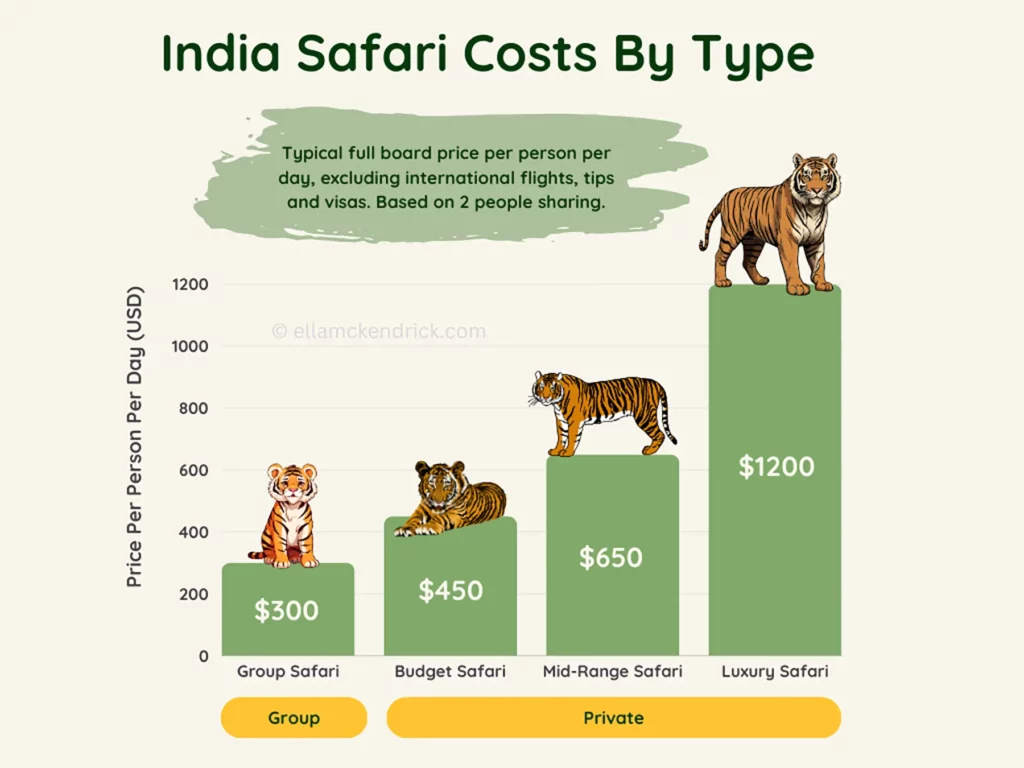
India’s Tiger Reserves are a gold-standard when it comes to conservation and limiting damage to the ecosystem. The number of permits offered is capped meaning that only a certain number of vehicles can enter the reserve at one time. Compare this to parks in Kenya or Tanzania where there is no cap. This visitor cap means there is a revenue cap for the reserve and in order to cover the costs to maintain the reserve they need to charge more per visitor.
Additionally, many tiger reserves close altogether in the monsoon season meaning that for half the year, the reserves aren’t bringing in any revenue. The reserves therefore need to charge more when they’re open so that they can cover the costs involved in maintaining the reserve year-round. Rangers will still need to patrol the reserves for poachers and staff will still be manning the gates to ensure no one enters illegally, regardless of if the reserve is open or not.
There are also zones within the reserves which receive no visitors at all. This is to allow nature a quiet spot to retreat from visitors, should they desire. Of course, these zones don’t bring in any revenue for the reserve as there are no visitors and yet money is still needed in order to maintain them. That money must come from somewhere and so an increase to permits makes the most sense.
The most expensive part of an Indian tiger safari is the permit to enter the reserve which is typically bundled in with jeep and driver / tracker hire. This typically costs between $200 and $300 per person per safari (you can double this cost if you plan on doing two safaris a day), depending on the reserve and day of the week.

Accommodation costs are significantly less, around $50 to $100 per person per night to stay in a jungle lodge within a buffer zone (within the reserve, just outside the core zones).
Transfers to and from the airport typically cost $250 to $400 (round trip) depending on the reserve you choose to visit.
You also need to factor in the cost of a domestic flight to the reserve as well, seeing as many reserves are located far away from international airports. A domestic flight is typically around $200 per person return.
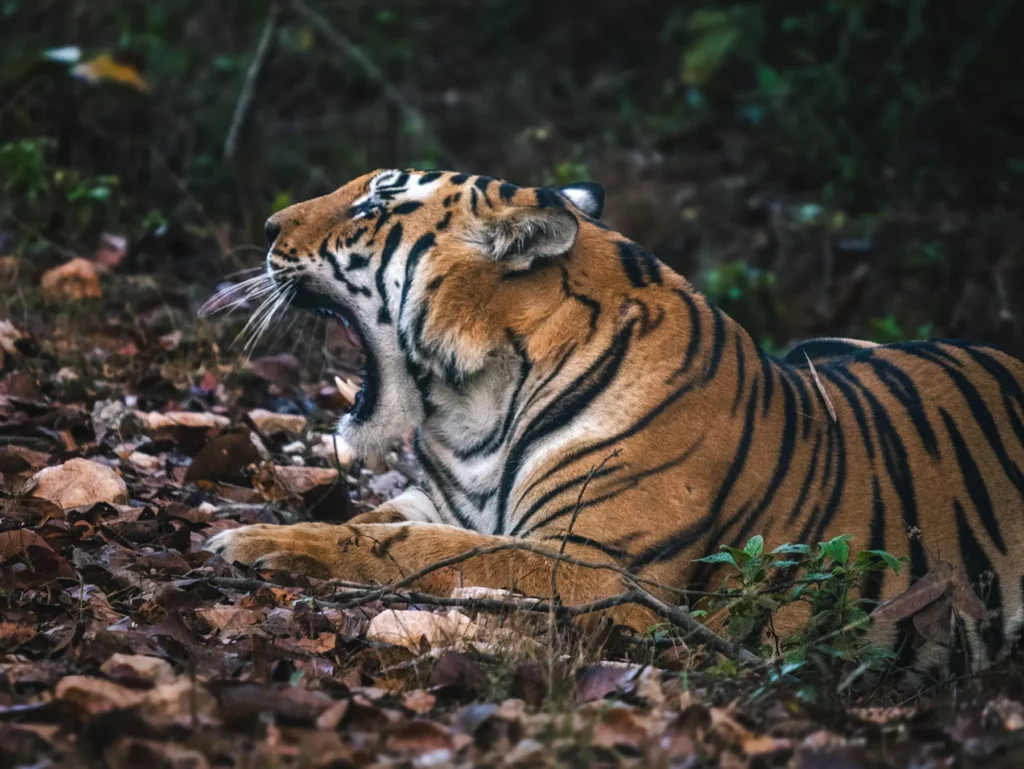
Factors Affecting Safari Cost
There are numerous factors that affect the cost of an Indian tiger safari. The exact park that you visit, duration of your stay, type of safari, whether you visit at the weekend or midweek (weekends are quite a bit more expensive) and level of comfort that you choose are the biggest factors to consider.
Whether you are an Indian national or foreigner also has a large impact. For simplicity, all prices I am giving in this article are assuming you are a foreign visitor to India.
Safari Accommodation
The accommodation that you select will perhaps have the biggest impact on your overall safari cost. When it comes to accommodation options, you have a range of budget, mid-range and luxury jungle lodges to choose from. The lodges closest to the core zones will be more expensive. However, the convenience of reaching the park gates in a fraction of the time is more than worth the extra cost, in my opinion.
Safari accommodation lodges in and around the tiger reserves in India are fairly plentiful, catering for basically everybody. You can find numerous lodges ranging from good value for money budget-friendly lodges, mid-range as well as 5-Star and beyond luxurious lodges, hotels and resorts.
For mid-range reasonable, clean and efficient accommodation, you can expect to pay $200 to $300 per day per person while budget-friendly joints could be as low as $50 per day per person.
Luxury accommodation can cost anything upwards of $500 per day and way beyond depending on the level of comfort that you may require.
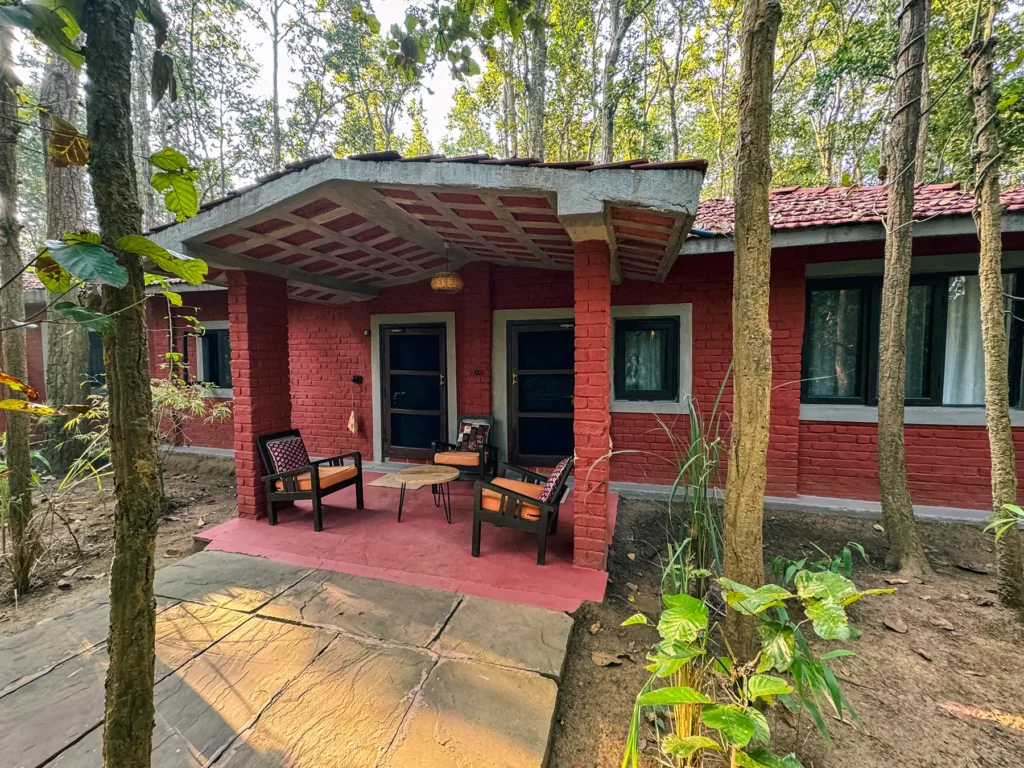
India Safari Park Fees Costs
Safari park fees vary between parks, day of the week that you visit, whether you visit a core or buffer zone and also between safari type. Below we will dive into these factors in more detail.
Shared Vs Private Tiger Safaris
The type of safari that you choose will also have an impact, with shared bus safaris being considerably cheaper than private Gypsy (jeep) safaris. There are however some huge drawbacks to taking a bus (sometimes referred to as canter) safaris.
First of all, as they’re shared, the bus needs to pick all visitors up from different locations before the safari starts. This can significantly eat into time when you should be on safari and cause you to miss the best time of day to try to spot tigers – first thing in the morning.
Secondly, you have no control over how loud the other guests in the vehicle are. As these buses can hold over a dozen people at once, things can get noisy pretty quickly. Tigers are elusive animals and don’t like loud noises and so you’re much more likely to scare them into hiding in a bus than in a private vehicle.
In my opinion, it’s already costing a lot of money to visit India and partake in a tiger safari and so it’s worth spending that bit extra to increase your chances of seeing a tiger.
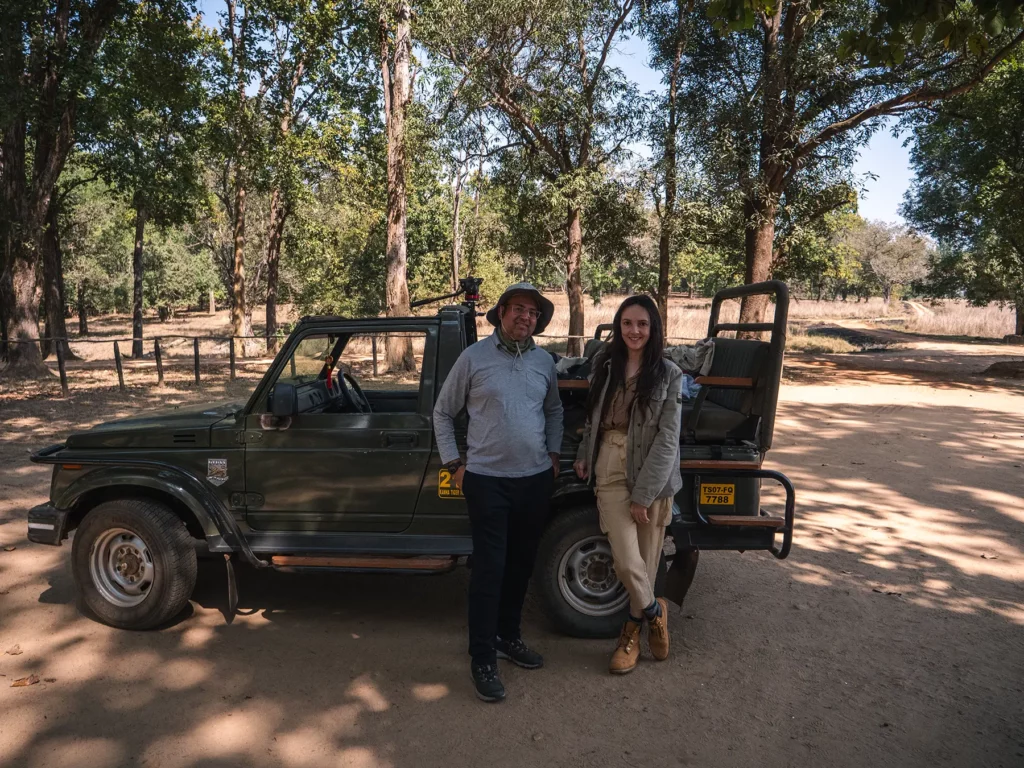
Safaris in Core Vs Buffer Zones
Another factor that affects cost is whether you go on safari in a core zone or a buffer zone. Your chances of seeing a tiger in a core zone are far greater than in a buffer zone so I don’t think it’s worth the financial savings of around $20 per person per safari.
Weekend Vs Weekday Safaris
If you wish to save money on your safari, I’d highly recommend visiting a tiger reserve midweek rather than at the weekend. Savings are typically around $40 per person per safari and so if you’re doing four safaris over a two day period, this can really add up.
Another benefit of visiting midweek is that the reserve will be a lot quieter. Safaris are a popular weekend activity for locals and so you miss the extra weekend traffic by coming on a different day.
Different Reserves
Park fees vary from reserve to reserve. A few factors determine the price of a reserve, including the likelihood of seeing a tiger and location.
Typically the most easily accessible parks, such as Ranthambore which is only 6 hours away by road from Delhi, are more expensive as demand for them is higher.
Additionally, the reserves where you are more likely to encounter a tiger are also more expensive. Again, this comes down to popularity. Visitors are more likely to visit reserves which are renowned for their sightings and this increases the prices.

Type of Safari Company for a Tiger Safari
Organising a tiger safari in India is no easy feat. The websites where you can purchase tickets online are often offline or glitching, making it virtually impossible to grab tickets without any assistance. The tickets offered on these websites are also inferior to tickets which can be obtained by reputable tour guides as they don’t allow you any flexibility in terms of what zone you’ll be allocated and you don’t even have the option to buy full-day tickets this way.
As organising a tiger safari entirely on your own is ruled out, there are only three viable options to booking your safari: through a local tour operator, through an international tour operator or through a jungle lodge or hotel.
The type that you choose will have an impact on costs with bookings made through international tour operators being substantially more expensive than bookings made with local operators or lodges.
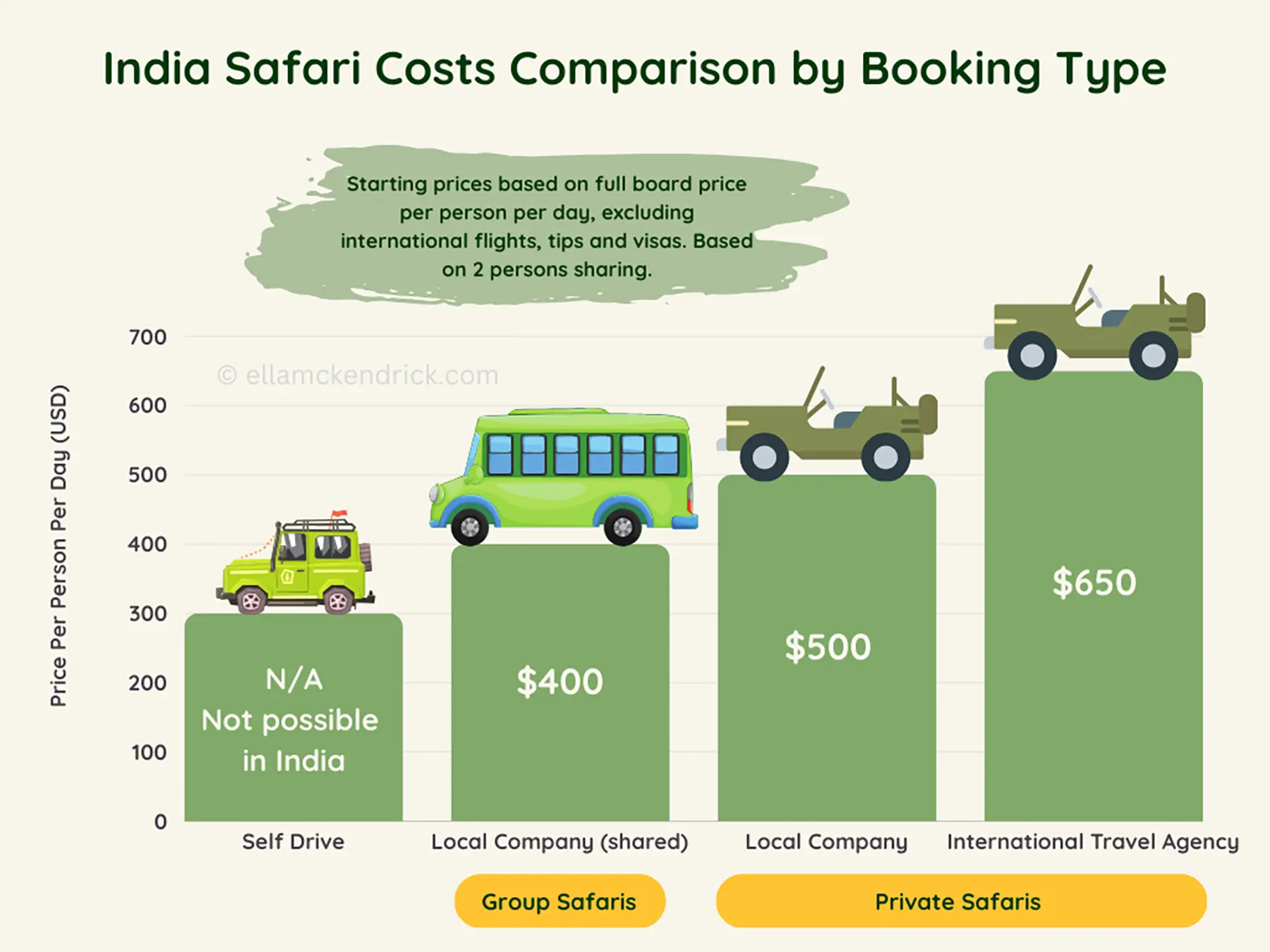
Time of Year
As everywhere else across the world, time of year also has a bearing on safari and travel costs in India. Between October and February are the most favourite months for safaris, but are also the most expensive ones too. November to February is the peak season in India as far as prices go.
While the cheapest rates are during the ‘off season’ (July to September), these are monsoon months and not a good time to view wildlife and especially tigers. Often permits are only available at this time of year for buffer zones which aren’t favourable for tiger sightings.
In general, October and the months of March and April are regarded as the ‘shoulder seasons’ during which prices are a little lower, but they vary hugely between lodges.
How You Travel Between Reserves
India is regarded as one of the most dangerous countries to drive in and Indian drivers are often rated as among the worst drivers in the world. City and village roads are usually narrow, full of potholes and extremely chaotic. National highways are better, but still narrow and often get congested, and if you have an accident, you could end up in a sticky situation at the very best.
Whilst driving is typically considered one of the cheapest forms of transport, I highly recommend that you avoid driving wherever and whenever you can. If you do have to drive between reserves, try to select reserves in close proximity to each other to cut down distances, time and level of risk and stress. It may be best to have your local tour operator arrange your transport between reserves, lodges and airports as they are often able to recommend reputable drivers who have safe vehicles.
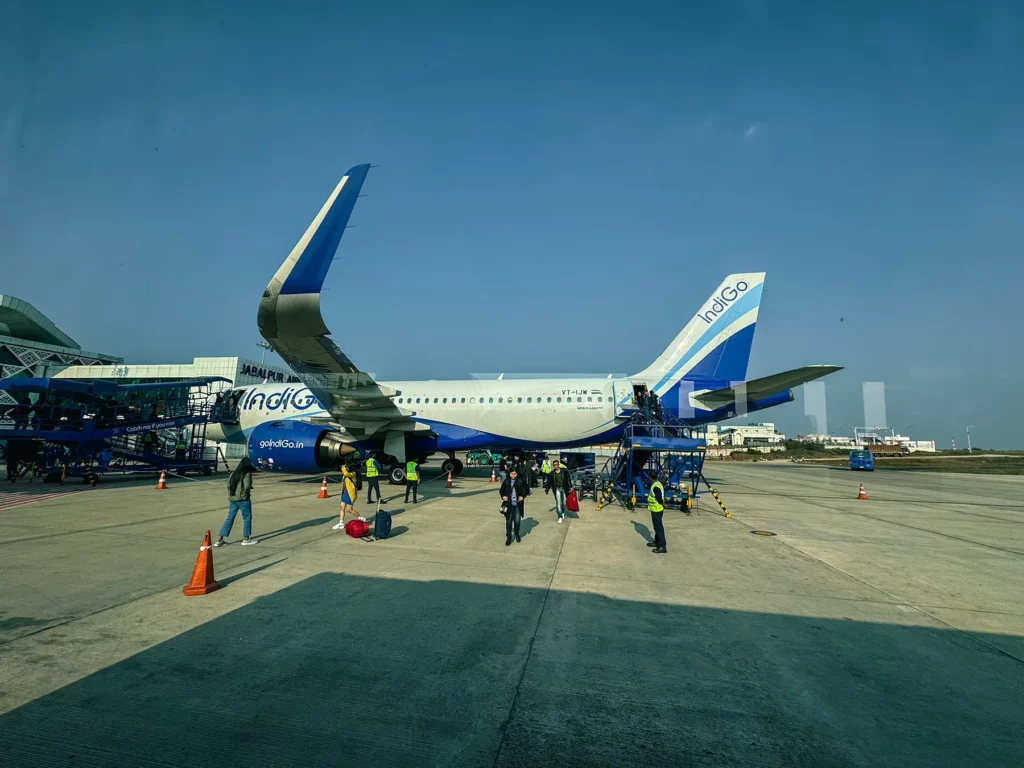
Fortunately, travelling by air within India is by far the quickest, least stressful, and most comfortable way of getting around, and is also surprisingly inexpensive. Most cities and towns have small domestic airports, served by various airlines, requiring only a short drive to your selected reserve, which your local tour operator can easily arrange.
With India being such a vast country, some of the remote tiger reserves are best accessed by air, eliminating the need to spend many uncomfortable hours or even entire days on the roads.
Another cheaper option is to journey by rail. However, this is certainly not the quickest mode of transportation and won’t take you directly to the reserves. You’ll need to use a combination of rail and driving in order to reach your safari location.

Best Time To Visit India for a Tiger Safari
The best time to visit India for a tiger safari is most certainly during the so-called winter months between October and February. The weather during this period is mostly clear, pleasant and mild, with temperatures averaging in the mid-20°C.
The landscape is also at its driest, the vegetation is sparse, grasses are shorter and animals tend to hang out close to water sources, like rivers, pools, lakes and swamps, making them easier to find.
The only negative aspect is that December and January is a popular time for travellers and so parks are at their busiest and prices at their highest.
In most areas, and particularly in higher elevations and in the northern parts of India, it gets pretty cold at night, with temperatures dropping below freezing. Morning game drives usually start at around 6 am and can be bitterly cold. Temperatures in the forests tend to be a lot colder than they are in the cities. Heavy and warm clothing is a must-have on safaris and it’s best to dress in layers, peeling off as the sun rises and the day warms up.
From April to June it may still be possible to visit India, but you’ll have to cope with oppressive heat on most days as the mercury reaches well over 40°C and in 2024 temperatures of over 50°C were recorded. In the extreme northern parts of India below the Himalayan foothills, April to June are usually far cooler and very doable.
It is highly advisable to avoid visiting from July to September, as this is normally the monsoon season in which heavy rainfall is the norm, with massive landslides often making roads inaccessible and game viewing, especially tigers, almost impossible. Most parks shut down their core zones, which is where tigers are mostly found, while many parks shut down completely during the monsoon periods.

How Many Days on Tiger Safari?
Just how many days you would need on a tiger safari, depends on a number of factors.
Much will depend on your choice of tiger reserve. Some tiger reserves have high densities of tigers, where you could spot them on your first game outing, while others are less populated, requiring several days and multiple safaris to make a sighting. And even then, no sighting can ever be guaranteed.
Fortunately, there are numerous tiger reserves situated close to each other in Central India, many of which have high densities of tigers. This makes it possible and affordable to visit a few without having to travel too far.
One must always bear in mind that tigers are possibly one of the most elusive and shiest of all large animals in the wild, despite their ferocious nature. They spend most of their time living solitary lives, sometimes with their cubs, hidden away in the dense vegetation and forests, preferring to avoid human contact whenever they can.
But coming to India, say from the UK, USA or Europe, takes some money and effort, so spending anything less than 5 days on safari may not provide sufficient time to appreciate the full splendour of India and its wildlife.
Unless you decide to spend all your time in one tiger reserve, you’ll also be spending some time travelling between different destinations. And even if you do choose to stay in just one park, travelling between the different zones will also take up valuable time of your holiday.
Visitors to tiger reserves in India are always urged not to be obsessed with just seeing tigers, but also to enjoy its varied wildlife, some of which is endemic and not found anywhere else in the world. Among these animals as well as some of the other critically endangered species include Asian leopards, cloudy leopards, Indian rhinos sloth bears, which are plentiful in most tiger reserves, Asian wild dogs and some of the most elegant and beautiful deer and antelope species on the planet.
One must also not forget the natural beauty that India has to offer, which differs vastly from one end to the other. Among this much varied landscape, you will also find historical and cultural sites as well as many fascinating people and buildings in the form of temples, palaces, forts and other significant landmarks to enjoy. Combining tiger safaris with some of these incredible sites can all result in a most memorable adventure of a lifetime.

How To Book Your India Tiger Safari
There are various ways of booking an Indian safari. But I must warn you, it’s not quite as easy as some would like it to be!
Here are the options available.
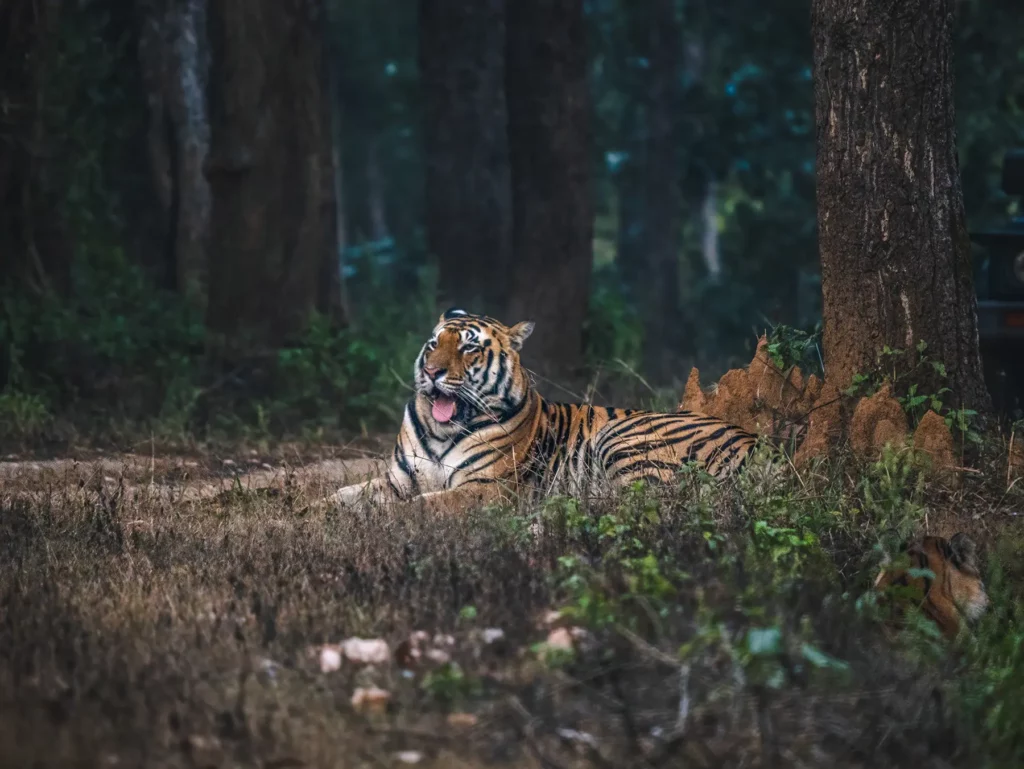
Option 1: Book Permits Yourself Through Government Website
Possibly the cheapest option would be to book online through the Government’s website, but the websites are often sketchy and misleading, resulting in many visitors being turned away when arriving at the gates. Website prompts are often difficult to follow with people finding it impossible to book their permits and tours. Additionally, the websites are often down or glitch.
Many websites make it difficult or don’t allow visitors to request a specific zone in the park, instead being allocated a zone which may not be good for tiger spotting. Having spent an enormous amount of money and effort getting there, finding that out at the gate can put a huge dampener on your overall trip.
Reserve websites are also often found to offer contradictory information regarding prices, adding to the confusion when trying to book online. The process too can be demanding, with different parks having different requirements, some of which being providing name, ID number and photo of each applicant, mode of safari, name of hotel or lodge you’ll be staying and to pay the entrance fee, vehicle fee and guide fee in full and in advance.
And if you’re planning to visit several parks like most visitors do, you’ll have to repeat the procedure with every reserve.
Based on my own experience and the experience of friends who have booked tiger safaris, this option isn’t really an option in the end due to the unreliable nature of the websites.
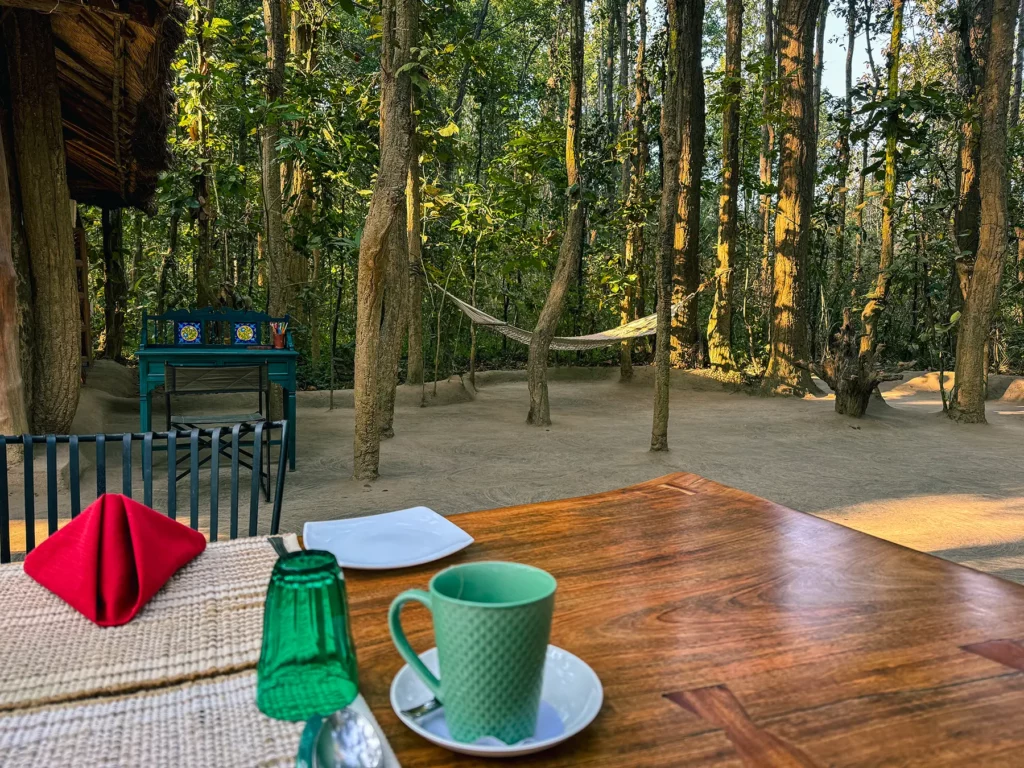
Option 2: Local Tour Operator
To avoid so much frustration and time wasting, without any doubt, booking with a local safari tour operator is by far the most convenient and easiest way to book your tiger safari.
They know all the ins-and-outs of all the parks and can take care of virtually everything, from the moment you land in India to getting you to the lodges and the parks and back to the airport. That takes all the hassle out of trying to do all that on your own.
Local tour operators allow you to visit multiple reserves, can arrange your transport, entrance fees, book the right safari vehicles, the correct zones, book your accommodation and your domestic flights too. Having built up a relationship with the reserves, they are able to advise you correctly on any information you would never have known on your own.
Local tour operators have access to the best guides and trackers within the reserve and have insider knowledge of the reserve’s tigers. They know all about where the most recent sightings have occurred and so can recommend the very best zones and reserves to you.
Local tour operators also have the ability to book full-day safaris for you, something which cannot be booked on your own or through a lodge.
Over and above all that, local operators are not much more expensive than booking everything on your own, partly down to the fact that they have great relationships with lodges who provide them with special rates.
How to Book with the Best Local Safari Companies
- Comparison sites which provide multiple quotes from verified suppliers such as Safaris By Ella
Join the rapidly growing tribe of over 1,000 travellers who’ve booked their dream safari using my insider tips and recommendations.

Option 3: Lodge Organised Safaris
Another option is to book your selected safari lodge and let them arrange the other logistics, like booking your safari and other needs. That may sound simple, but that still leaves you to select the right lodge that meets your needs and that it’s actually conveniently located within or close to your preferred tiger reserve.
Also note that you’ll be choosing a lodge whilst being blind to where recent sightings have been located and so may end up selecting one beside the wrong zone.
You would also still be required to arrange your own transport getting to your lodge from the airport and this becomes even more complicated if you’re wanting to visit multiple reserves.
You would have to repeat this palaver with each lodge you book. Some lodges also cannot request the zone you may wish to go to in a reserve, and you can end up in a zone with a low chance of spotting a tiger.
How to Book a Hotel-Provided Safari
- Option 1: My recommended tour operators on Safaris By Ella can arrange hotels and air or road transport to and from the hotels. If you opt for the more cost-effective road transport, since they have driven you to the hotel, you might find it cheaper to use the safari company for safaris rather than using the hotel-provided safaris.
- Option 2: Check with your chosen accommodation whether they provide this service and the booking requirements.
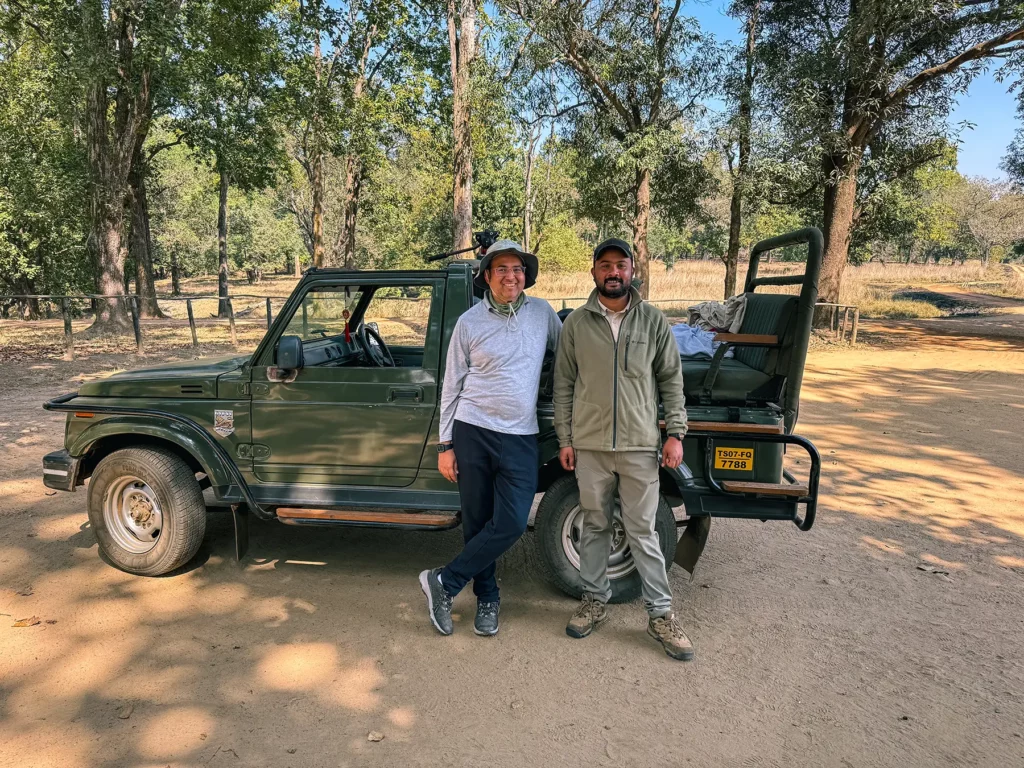
Option 4: Overseas Tour Operators
Overseas tour operators may sound the most convenient way of booking, but although they may be the best to arrange your international flights, when it comes to all the domestic logistics, they normally sub-contract local tour operators and mark up the costs to make a profit.
The end result for you is that you pay much more for your trip, but the safari experience remains the same as booking through a local tour operator.
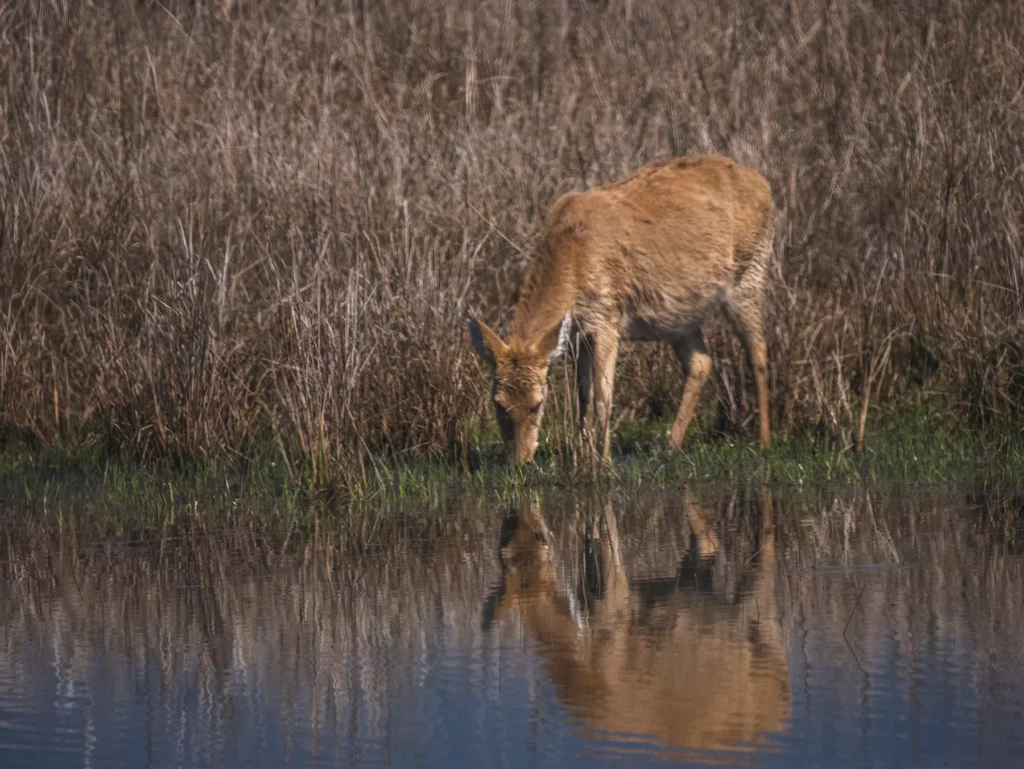
How To Choose A Tiger Safari Company in India
Choosing a tiger safari company in India can be one of the most crucial factors to ensure you get to see at least one of these enigmatic cats in the wild.
As with most professions in life, you get good and bad no matter where you go, but having spent so much time and money getting to India, you would want to find the very best.
Fortunately, today’s technology makes it a little easier for us.
You can watch YouTube videos for first hand experiences. I have a YouTube video coming very, very soon of my own tiger safari experience in India!
Additionally, looking at the numerous reviews available on platforms such as Google or TripAdvisor provides a realistic overview of the company’s service and track record. To be fair to them, one must also make a few allowances as no matter how good a company may be performing, there will always be some disgruntled customer somewhere along the line. What’s even better is to speak to someone who has actually used this particular tour operator and see if they match up with your specific needs.
I’ve had the pleasure of going on tiger safaris with some absolutely fantastic local tour companies. Their knowledge and expertise allowed me to spot six individual tigers in a mere two days in Kanha Tiger Reserve, one of the more challenging reserves to find tigers.
I can’t put this down to just luck as we saw a gentleman who saw not a single tiger on the same day that we saw three. Even worse, he’d been on safari for 5 full days in Kanha and hadn’t seen a single tiger! Ouch.
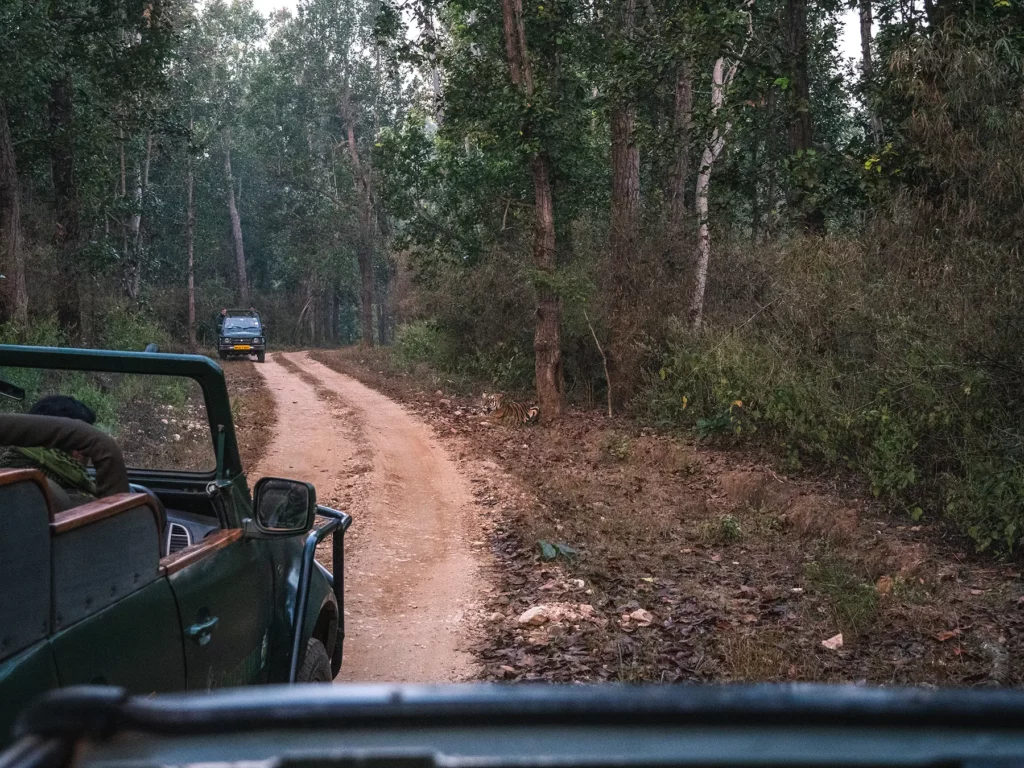
Special Interest / Unique Safaris
Apart from normal jeep, bus, and boating safaris, good tour operators may also offer a range of specialist safaris, targeting various other wildlife species and activities. These types of safaris generally cost a lot more, as they require the services of specialist guides, equipment and specially modified vehicles.
Just a little note here before I dive into the specialised safaris. Many reserves offer elephant safaris, where you traverse the jungle on elephant-back. I don’t however recommend these. Elephants are incredibly intelligent beings who I firmly believe shouldn’t be domesticated. The domestication process typically involves crushing their spirit which I find heartbreaking. So, let’s instead admire these creatures in their natural habitat.
Here are some of these specialised safaris that may be on offer in the various reserves.
Tiger Photo Safaris
Tiger photo safaris require the services of not only a professional photographer who can offer technical advice, but one who is also knowledgeable on the actual reserve topography and the habits of tigers and the other wildlife.
They eliminate driving aimlessly around the park hoping to stumble upon an animal, knowing to take you straight to places where tigers are likely to be at that particular point in time. They will also be aware of the tiger’s habits and anticipate their moves, putting you in a position to get the best possible shot.
You would have to be watchful and be ready at all times as tigers are extremely shy creatures and don’t hang around for too long once you spot them. They can appear out of nowhere and disappear even quicker and the moment can be gone in a flash.
Vehicles may also be modified to allow good views on all sides and fitted with bars to fix cameras onto. They take a limited number of passengers which does add to the higher costs of a photo safari.
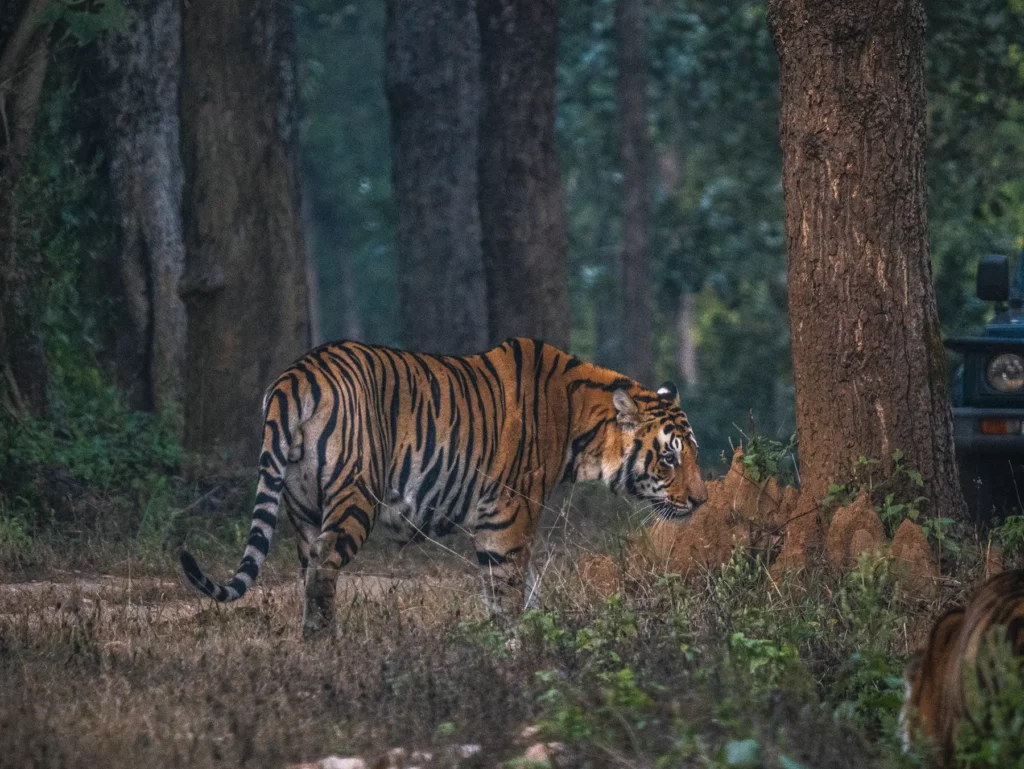
Walking Tiger Safaris
While walking safaris are popular in most game parks across Africa, in India, they are only allowed in a handful of reserves including Satpura National Park.
Satpura is one of the largest parks in India with a relatively low population of tigers, which drastically reduces the risk of a dangerous encounter. This park is also one of the most picturesque and has a rich and varied population of other less threatening wildlife species.
Seeing the wildlife aboard a jeep is one thing but being on foot in the wild is a completely different experience, adding to the adventure element of a true safari. Being on foot allows you to get really close to nature, the animals and birds and you get to notice smaller creatures, not easily sighted from a crowded truck.
Walking safaris in Satpura start at dawn and can last for the entire morning, or you can embark on a multi-day hike staying over in different camps every night across the park. Groups are limited to about 10 and you’ll be accompanied by an experienced ranger. Multi-day hikes involve a minimum of 7 hours of walking every day and are restricted to people of moderate health and fitness levels.
Being a less visited park, a walking safari allows you to truly appreciate the beauty and quietness of the forest and view game such as Indian bison, several species of deer, sloth bears, foxes, flying squirrels, monkeys, and various bird species, including the exquisite peacocks.
You also have the time to appreciate the environment as you tread in the dense forests, across the meadows or along streams, listening to the sounds of nature with all your senses on high alert.
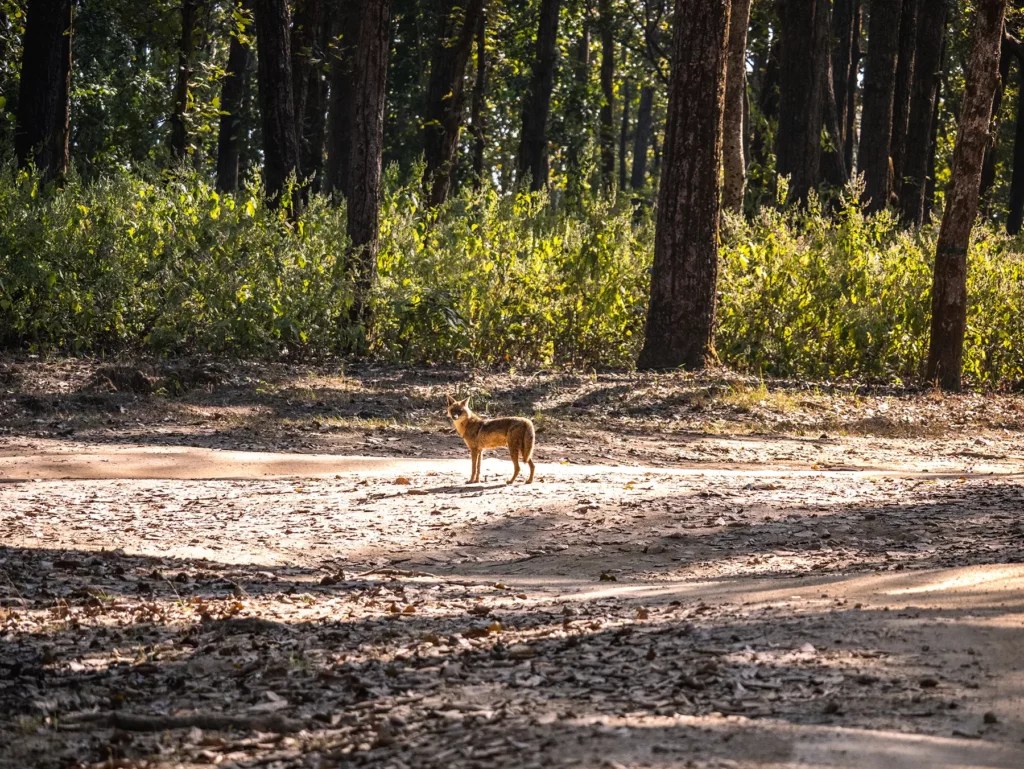
Self-Drive Tiger Safaris
Unlike Africa where self-drive safaris are fairly common in most parks, they are not possible in India. The only cars that are permitted to enter the reserves are part of the reserves’ own fleet of similar-specification jeeps and buses. Each vehicle is numbered.
Preventing self-drivers from entering the reserves both helps to preserve the topography, and keep the animals and visitors safe. Qualified drivers understand the terrain and roads like the back of their hands and also understand wildlife behaviour, whereas just a regular driver wouldn’t and could endanger themself or the animals.
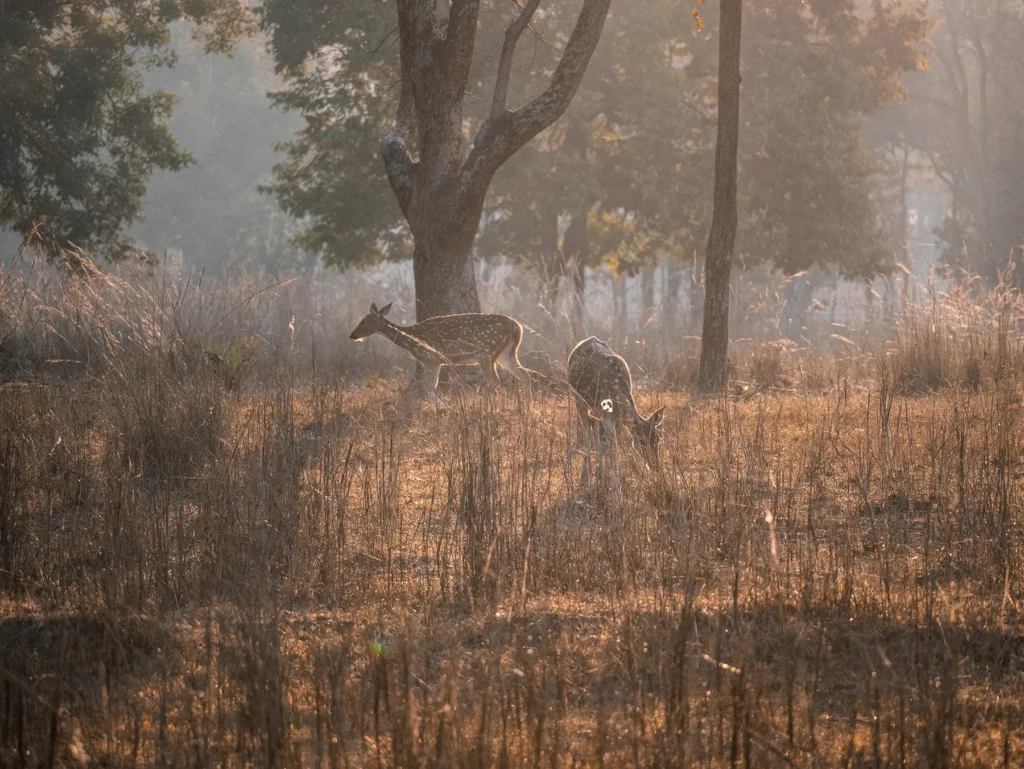
India Tiger Safari Safety
Whilst tiger safaris are considered safe, there are certain precautions to take on an Indian tiger safari to ensure that no hairy situations arise, for neither yourself nor the wildlife.
Wildlife
Never forget that the animals you are viewing on safari are wild and deserve our respect. Therefore remain quiet and calm in their presence and avoid getting too close to them. Generally, wildlife in India is uncensored about vehicles. However, should you behave recklessly, you could make them feel threatened and this is where incidents can occur.
Tigers have been known to kill people in India. These incidents tend to take place in villages close to jungles, outside of the reserves, not on safaris. The tigers involved in these incidents are often sick or injured or unable to access their usual prey.
Tiger reserve guides adhere to a strict set of safety rules and as long as everyone sticks to their instructions, there should not be any threat. The golden rules on any safari include staying in the vehicle at all times and not making any noises or gestures which may provoke an animal. Luckily, tigers are naturally shy creatures and try to avoid all human contact and never attack unless they feel threatened.
Flooding and Natural Disasters
These occur regularly in India, but only during the monsoon season which is between July and September. Most parks shut down either their core zones or altogether during this period.
Visiting outside of the monsoon season massively reduces the risk of any natural disasters.
Terrorism
Terrorism is a constant threat across the world and India is no exception. Most terrorist acts take place in the extreme north mainly in the Kashmir Region with only a few isolated incidents in central and southern India. At times religious and political unrest flares up, causing some inconvenience.
India is very much on high alert for terrorist attacks. To enter hotels and attractions in major cities such as Delhi you are often screened by a body scanner and your bags need to go through an X-ray. Cars are also checked over when entering car parks for hotels, restaurants and malls. These precautions help to keep everyone safe.
I’ve also never encountered such high security as I have at the airports in India. My whole bag was emptied and had to go through the scanner multiple times. My electric toothbrush in particular raised some eyebrows and I had an allen key confiscated. They certainly go by the motto ‘better safe than sorry’.
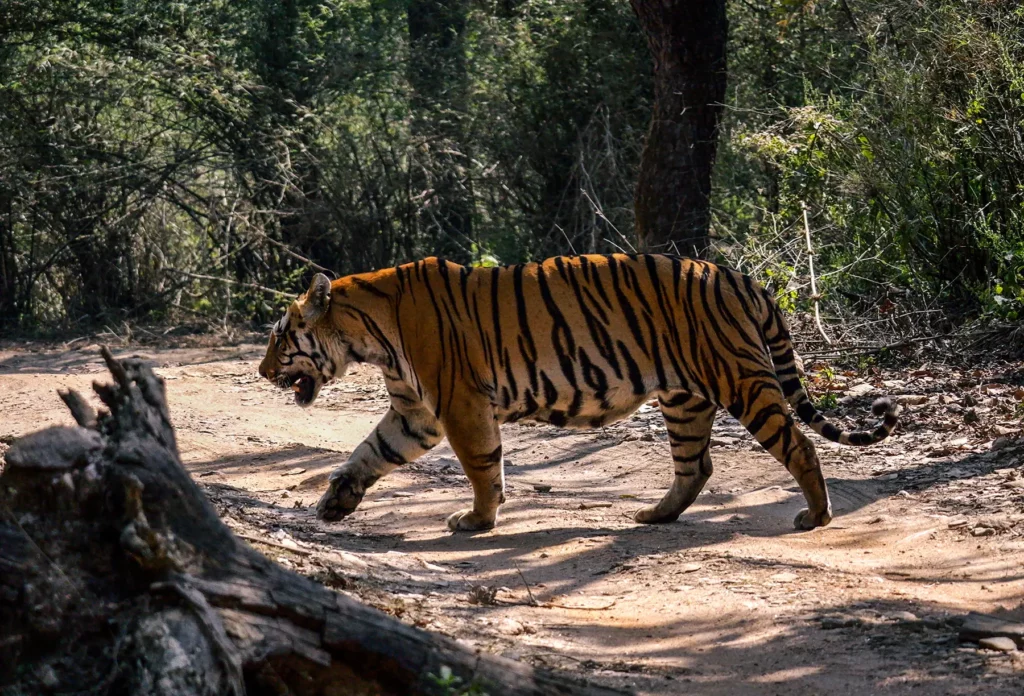
Crime and Petty Theft
Like pretty much anywhere in the world, this can be a problem particularly in busy public places such as on buses, trains, at airports, restaurants, major tourist sites and in city streets.
Expert pickpockets are known to snatch bags or slit bag and purse straps and disappear without anyone noticing.
Additionally, avoid buying expensive goods like carpets and jewellery from dodgy vendors, as there are many con artists selling counterfeit and pirated goods.
Like anywhere in the world, one needs to avoid flashing cash, wallets or jewellery in public. Also be aware of card scams around ATMs or whenever using your card.
Car Accidents
India gets a bad rep when it comes to its roads. And having driven on them, it’s very easy to see why. There are basically no laws on the road. Cars, tuk-tuks, buses, bikes and cows all jostle for space, entering the road without any warning and driving perilously close to one another.
Whilst cities are by far the most congested areas, vehicles are never travelling at too great a speed so accidents consist of bumps and scrapes, nothing too drastic. Travelling longer distances, however, can be a little more risky.
There’s an average of over 50 road accidents every hour in India and the most common cause of accidents is driving on the wrong side of the road.
I’d always recommend keeping driving to a minimum, if possible. For example, if you’re wondering whether to drive 15 hours to a reserve or take a place and then a 4 hour drive, take the plane.
Avoiding the roads altogether is inevitable. However, it may make you feel better to learn that, India ranks only 88 for countries with the highest number of deaths on the road per 100,000 inhabitants with only 15 deaths which is pretty low.
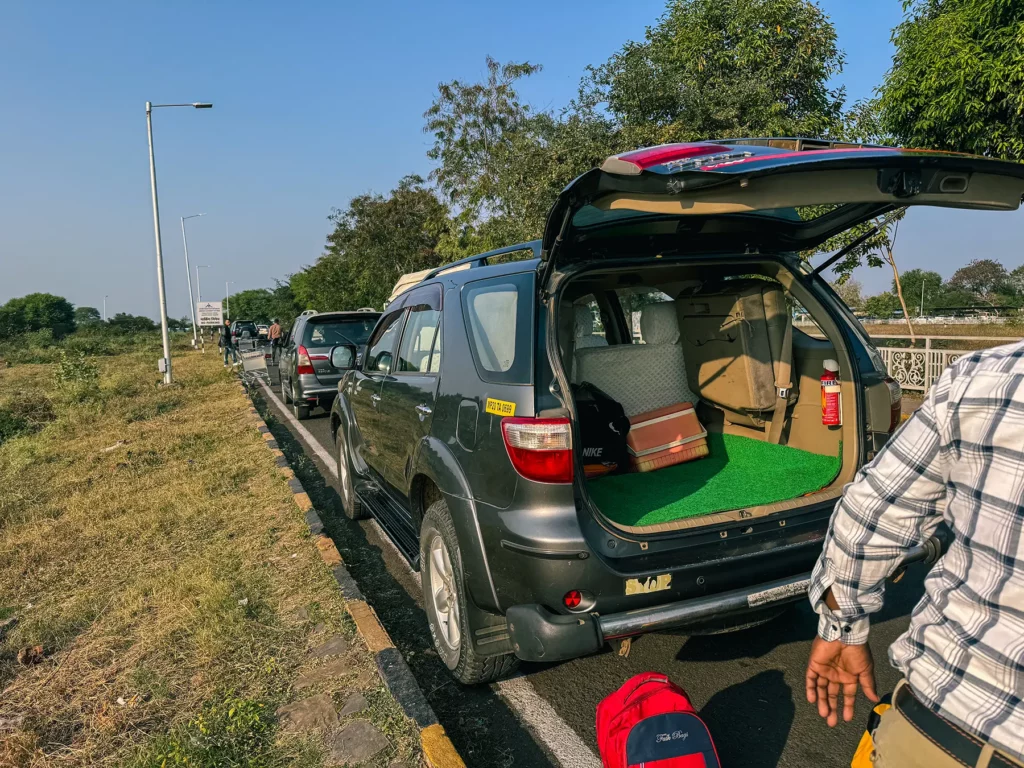
Plane Accidents
According to statistics going as far back as 1945, there is 10 times less chance of a plane accident happening in India than it is in the USA. Air travel remains the safest way to travel in India.
Food Poisoning
Food poisoning is a constant threat in India but as long as you practise some good old fashioned savvy, it’s not inevitable. I survived a whole 2-week stint without a hint of food poisoning which I was over the moon about.
Tap water is a no-no for starters and that goes for ice too (including ice cream). Avoid street vendors at all costs as their food may be cooked but it may have been sitting in the sun for hours and may have started to go off. The heavy aromatic spices will disguise any bad odour or taste. I can’t tell you how many people I know who tried Indian street food and spent the next week on the toilet.
Avoid uncooked food (for example salads) even in hotels and restaurants as they have possibly been washed with contaminated tap water. Peeled or diced fruit are another no-no. Instead eat bananas that you have peeled yourself. Also stick to restaurants that have been recommended or have extremely high online reviews.
I don’t mind roughing it on my travels in budget accommodation at times but in India I went for high-end hotels and lodges for every single night in order to avoid food poisoning. I looked for hotels which had highly-rated restaurants within them and this strategy very much worked for me.
On safaris or long road trips try to pack some safe snacks with you and plenty of filtered water. I like to buy protein bars back home in the UK and then bring them on trips with me, just in case I’m in an area with no reputable restaurants.
Wash your hands regularly, especially after handling money and using the bathrooms. It’s also wise to carry some sanitiser and anti-bacterial wipes with you to wipe eating utensils and other items.
If the Delhi Belly does get you, it’s not the end of the world. Just treat yourself with some anti-diarrhoea or anti-nausea medication and a few electrolyte replenishing sachets you brought with you.
Diseases
Some parts of central and southern India have a malaria risk, so if you’re visiting these areas it’s best to ask your doctor or pharmacist to advise you on a medication best suited to you. Remember that medication needs to start before arriving in India.
Many of the key tiger reserves such as Ranthambore and Jim Corbett are not in malaria areas.
Other mosquito related diseases such as Japanese Encephalitis can be contracted in India. You can view a full list of diseases that it’s recommended you get vaccinated against here.
Rabies is also a threat, not only from dogs, but from the various monkeys that thrive in the parks of India. It’s recommended that you don’t touch any animals in India, not even friendly-looking dogs as they could carry rabies.
India is not a Yellow Fever area, but a vaccine certificate needs to be produced if you’re arriving from a country with a risk of Yellow Fever. Certain vaccines along with several precautionary measures are however recommended.
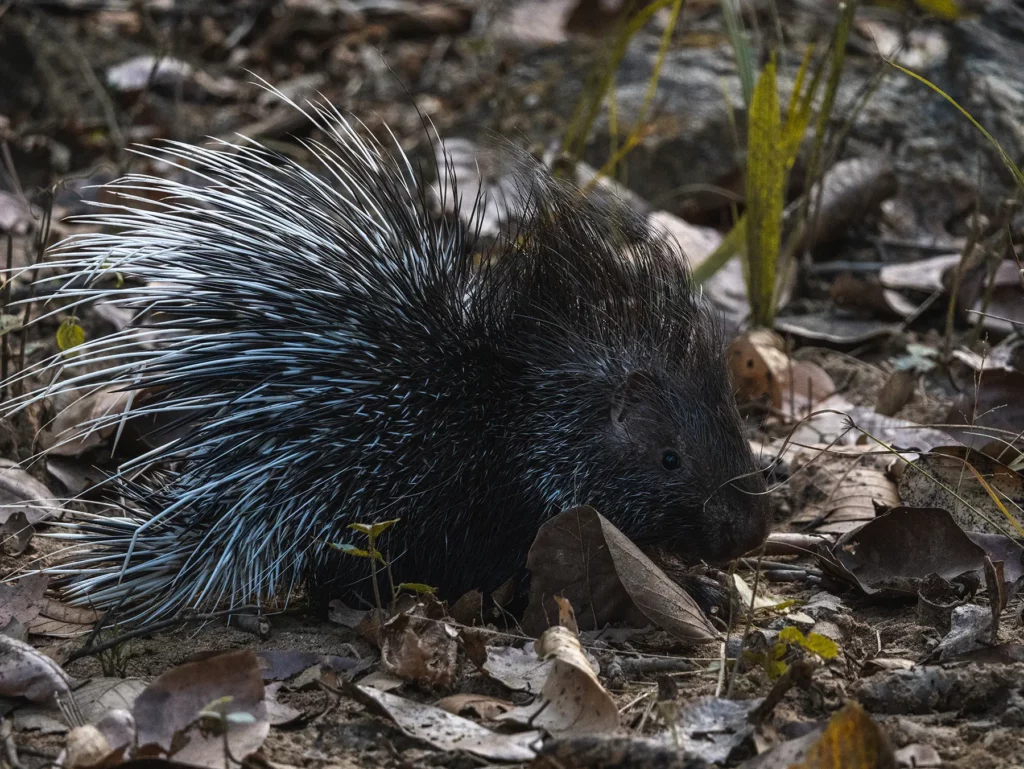
India Tiger Safari Logistics
Apart from packing your clothes and some toiletries you’re going to be needing, there are a few other logistics that need attending to. Planning well ahead is the first one.
Travel Documents
Nobody goes anywhere without a valid passport, so ensure yours is valid for at least a further 6 months after your planned return.
Visas are required for visitors from most countries and they can be applied for online. Normal tourist visas are valid for 60 days, cost $69 and are usually issued within 3 working days. You cannot get a visa on arrival in India so applying online is imperative. The process is very arduous and you’ll have to jump through a few technical hoops so do allow ample time for it.
Vaccines & Medications
No vaccines are required for India, except if you’re coming from a country or even have transited through an airport in a country with a high risk of Yellow Fever. However, there are several that are recommended.
The most common illness visitors need to be wary of in India, are food poisoning and heat exhaustion. Unless left untreated for a period of time, none can cause any long term serious effects. A few days of rest and rehydration will usually do the trick. If you don’t have any rehydration sachets, warm coke with a sprinkling of salt works well too.
Currency
The currency of India is the Indian Rupee, abbreviated as INR. Hotels, lodges, shops and restaurants accept the usual credit or debit cards like Visa, MasterCard, American Express and Diner’s Club as well as Indian rupees in cash.
It’s quite easy to exchange US dollars, British Pounds and Euros as well as Canadian and Australian dollars.
There are no shortages of ATMs in the airports and cities, from which you can use your cards to draw cash to pay for minor goods or for tipping.
When travelling to some of the remote parks and locations across India, it’s wise to carry sufficient cash on you as ATMs are often unavailable.
Gratuities (Tips)
Tipping for good service across India is recommended. It’s recommended that you tip your drivers, hotel porters and for meals at restaurants.
It’s also recommended that you tip your safari tracker and driver. $10 per person per safari ($20 per person per day) is a good place to start for each person.

Best India Tiger Safari Itineraries
In case you’re still undecided as to how long to stay in India or which tiger reserve to visit, I have put together 4 different options, all concentrated in Central India, to parks which should provide you the best odds of seeing tigers.
3-Day Ranthambore Tiger Safari Itinerary
This is the shortest itinerary and is limited to one tiger reserve to avoid wasting valuable time driving on the roads. Ranthambore Tiger Reserve is one of the most popular parks in India and although it is one of the largest, its high population of tigers should provide a sighting or two during your short stay.
Apart from tigers, there is also a wide range of other wildlife such as leopards, sloth bears, striped hyenas, jackals, warthogs, crocodiles and a large variety of deer as well as a rich population of birds.
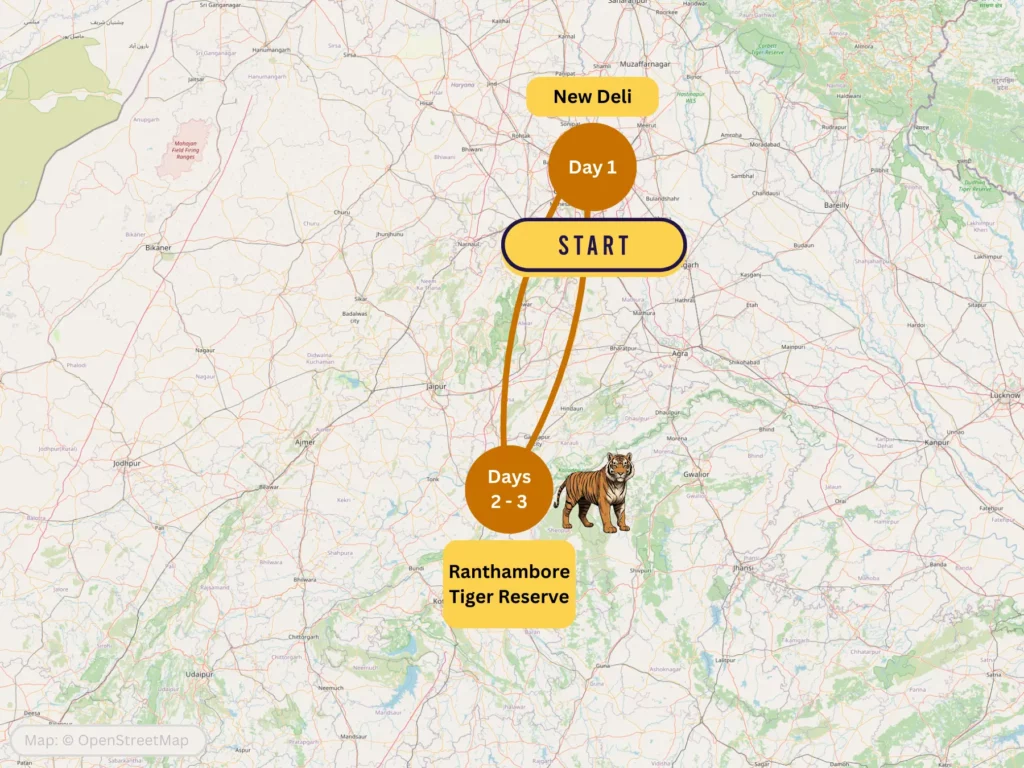
Day By Day Breakdown of 3-Day Ranthambore Tiger Safari Itinerary
Day 1: Delhi to Ranthambore Tiger Reserve
Total driving time (excluding game drives): 6 hours
On arrival at Delhi Airport, you’ll be met and driven to Ranthambore Tiger Reserve, in time for your first tiger safari in India in the afternoon. This will be done in a 6 seater open Jeep.
The driver/guide will select one of the core zones of the park, which tend to provide you the best opportunities to spot a tiger and many other species.
At the end of the drive in the late evening, you’ll be driven back to your selected lodge in time for dinner and a well-deserved rest.
Day 2: Ranthambore Tiger Reserve
Total driving time (excluding game drives): 0 hours
Day 2 starts with an early morning game drive through the park before being taken back to spend the rest of the morning enjoying your lunch and relaxing at the lodge.
It is vital to be up and in the park as early as possible as this is the best time to view the wildlife. As the sun and temperatures start rising, the game, and especially tigers, head for the cover of the bushes to escape the midday heat.
In the late afternoon you’ll embark on another game drive, hopefully catching some of the animals as they emerge from the dense vegetation.
Overnight at your lodge.
Day 3: Ranthambore Tiger Reserve to Delhi
Total driving time (excluding game drives): 6 hours
Once again you’ll set off on your last game drive really early in the morning, followed by the afternoon drive back to Delhi where your 3 day tiger safari ends .
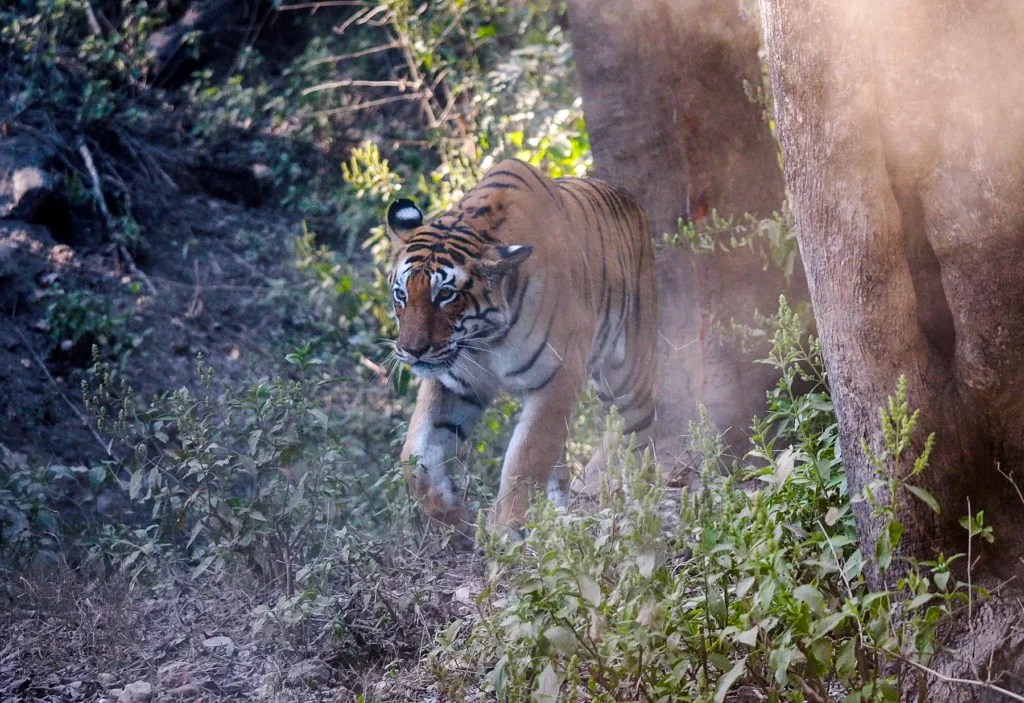
Recommended Booking Options For Your India Tiger Safari Itinerary
Safari with local tour operator
Most popular & best experience – typical prices for this itinerary start from $400 per person per day.
Visit safarisbyella.com for free quotes from trustworthy local tour companies I use to book my own trips.

5-Day Kanha and Bandhavgarh Tiger Safari Itinerary
This is a slightly longer itinerary which gives an opportunity to visit two tiger reserves in Central India, both of which have a high density of tigers, providing reasonably good chances of seeing a few. Distances are a little far so an internal flight is necessary to avoid spending long periods on the roads.
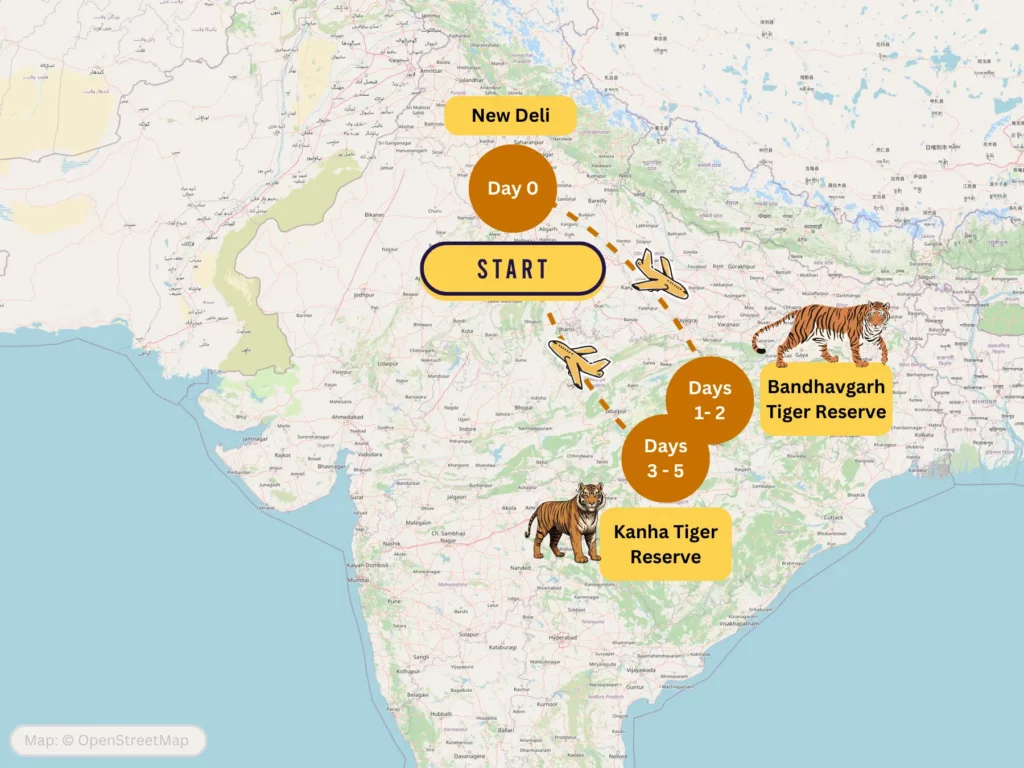
Day By Day Breakdown of 5-Day Kanha and Bandhavgarh Tiger Safari Itinerary
Day 1: Delhi to Bandhavgarh Tiger Reserve
Total driving time (excluding game drives): 2 hour flight and 5 hour drive
After arriving in Delhi, you’ll take a 2 hour flight to Jabalpur, from where you’ll be driven on a 5 hour drive to your lodge at the Bandhavgarh Tiger Reserve. This ordeal will take almost the entire day.
Day 2: Bandhavgarh Tiger Reserve
Total driving time (excluding game drives): 0 hours
After a good night’s rest, you’ll set off really early in the morning on your first tiger safari in India, where you’ll hopefully make your first sighting of at least one of these stunning predators.
This scenic park also has a dense population of leopards, wild dogs, Indian wolves, sloth bears, Indian bison, known as gaur, herds of various deer and over 300 species of birds.
This park offers several historical landmarks as well as several view sites to enjoy spectacular scenery of the entire park and surroundings. After lunch and a short rest at your lodge, you’ll set off on another game drive returning in time for dinner.
Day 3: Bandhavgarh to Kanha Tiger Reserve
Total driving time (excluding game drives): 5 hours
After another morning drive in Bandhavgarh, you set off on a 5-hour drive to Kanha Tiger Reserve, situated about 99 miles (160 km) to the south.
This is one of the bigger parks and considered among the finest in India, with a core area of almost 386 square miles (1,000 km²), providing good odds of seeing tigers.
Overnight at Kanha.
Day 4: Kanha Tiger Reserve
Total driving time (excluding game drives): 0 hours
You’ll spend the day going on 2 game drives in open Jeeps, meandering through the lush meadows, green forests and several rivers and streams coming across its varied wildlife which also includes leopards, wild dogs, sloth bears, Indian bison, wild boar and literally thousands of various deer including the rare Barashinga.
Overnight at Kanha.
Day 5: Kanha Tiger Reserve to Delhi
Total driving time (excluding game drives): 6 hour drive followed by 2 hour flight
On day 5, you drive for 6 hours to Jabalpur to catch a 2 hour flight to Delhi where your Indian tiger safari ends.
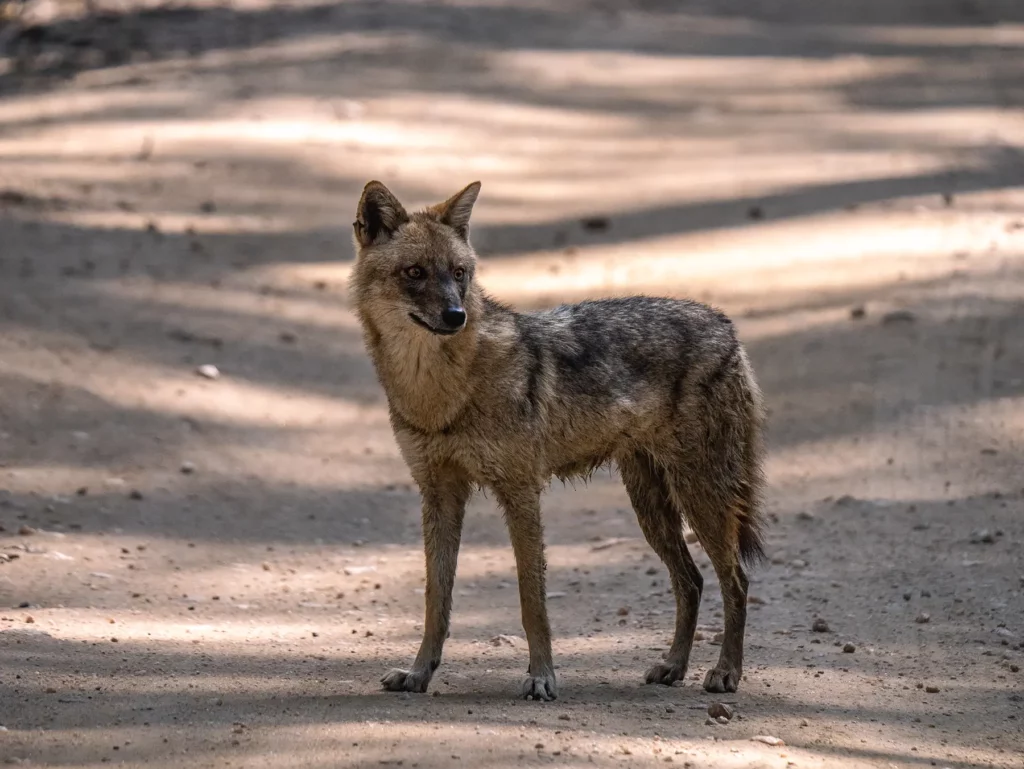
Recommended Booking Options For Your India Tiger Safari Itinerary
Safari with local tour operator
Most popular & best experience – typical prices for this itinerary start from $400 per person per day.
Visit safarisbyella.com for free quotes from trustworthy local tour companies I use to book my own trips.

Ultimate 7-Day Kanha and Bandhavgarh Tiger Safari Itinerary
This longer and less rushed itinerary is far more relaxing and enjoyable, providing 5 full days of safaris in 2 tiger reserves, setting aside 2 full days for travel.
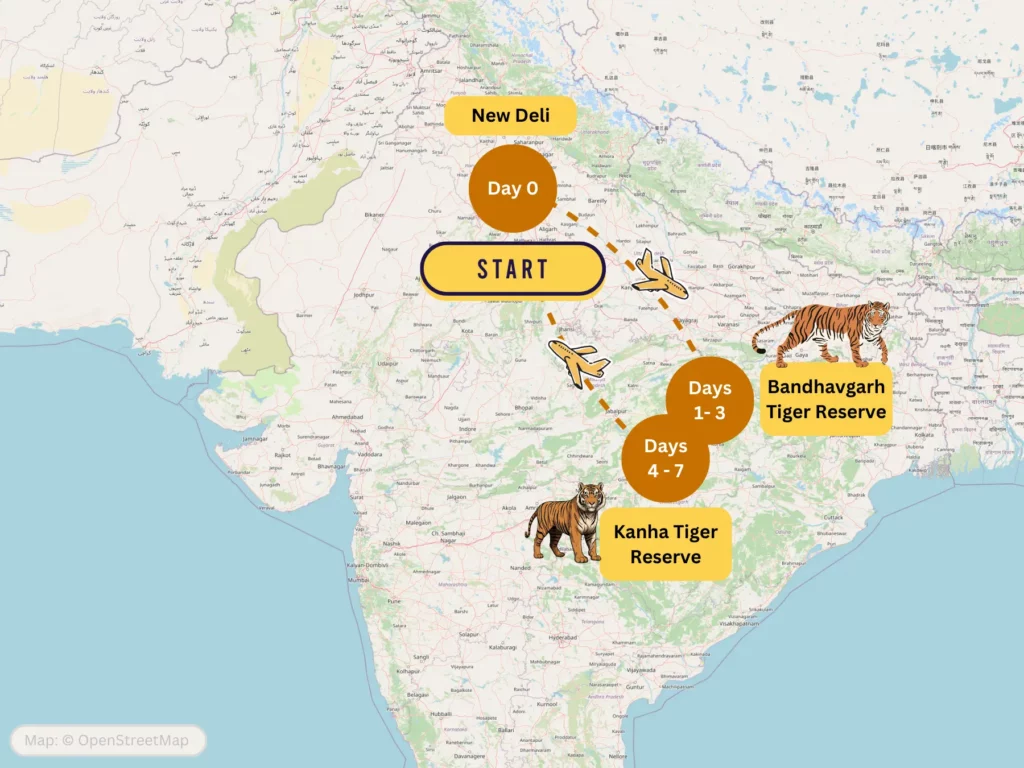
Day By Day Breakdown of Ultimate 7-Day Kanha and Bandhavgarh Tiger Safari Itinerary
Day 1: Delhi to Bandhavgarh Tiger Reserve
Total driving time (excluding game drives): 2 hour flight and 5 hour drive
The first day is entirely taken up travelling.
Upon arriving in Delhi, you take a 2 hour flight to Jabalpur, followed by a 5 hour drive to Bandhavgarh Tiger Reserve, arriving in time for dinner and a well-deserved rest.
Overnight at Bandhavgarh.
Day 2 – 3: Bandhavgarh Tiger Reserve
Total driving time (excluding game drives): 0 hours
You’ll be spending the next two days exploring this vast and picturesque park in an open Jeep going through lush meadows, forests and swamp areas teeming with wildlife, including a high population of tigers.
Other wildlife may include leopards, wild dogs, sloth bears, Indian bison, tons of deer species and nilgai, the largest antelope in Asia.
After your early morning game drive, you’ll be driven back to your lodge where you can enjoy your lunch and a few hours relaxing in the lodge’s grounds, before embarking on your afternoon game drive through the core zones of the park, where tigers are likely to be found.
Overnight at Bandhavgarh.
Day 4: Bandhavgarh to Kanha Tiger Reserve
Total driving time (excluding game drives): 5 hours
After your final morning game drive at Bandhavgarh, you’ll be driven on a 5-hour trip to Kanha Tiger Reserve, situated about 99 miles (160 kilometres) to the south, where you’ll be spending the night.
Day 5 – 6: Kanha Tiger Reserve
Total driving time (excluding game drives): 0 hours
The next two days you’ll spend going on morning and afternoon game drives exploring the core zones of this park famous for its tiger population, as well as its varied and dense concentration of other animals and over 300 species of birds. This is one of the parks that was the inspiration behind the famous children’s book and subsequent animated Walt Disney films ‘The Jungle Book’. This is the home of Mowgli, Shere Khan, Baloo and the rest of the gang.
The hours between game drives, you’ll spend at your leisure, having lunch and relaxing at your lodge.
Day 7: Kanha Tiger Reserve to Delhi
Total driving time (excluding game drives): 6 hour drive followed by 2 hour flight
Your last day will be spent in transit, first driving for 6 hours to Jabalpur and followed by a 2 hour flight back to Delhi.
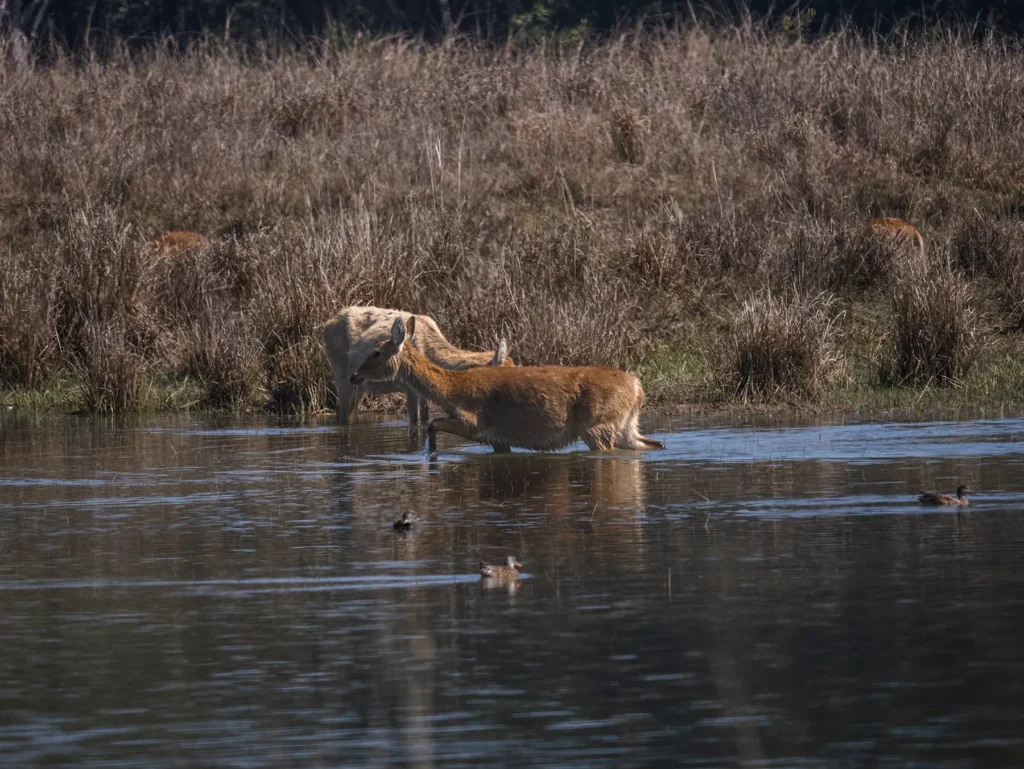
Recommended Booking Options For Your India Tiger Safari Itinerary
Safari with local tour operator
Most popular & best experience – typical prices for this itinerary start from $400 per person per day.
Visit safarisbyella.com for free quotes from trustworthy local tour companies I use to book my own trips.

Ultimate 10-Day Tiger Safari Itinerary
This is the most ideal itinerary, allowing you ample time to explore 3 of India’s premier tiger reserves and time to relax in between. All are conveniently situated in Central India.
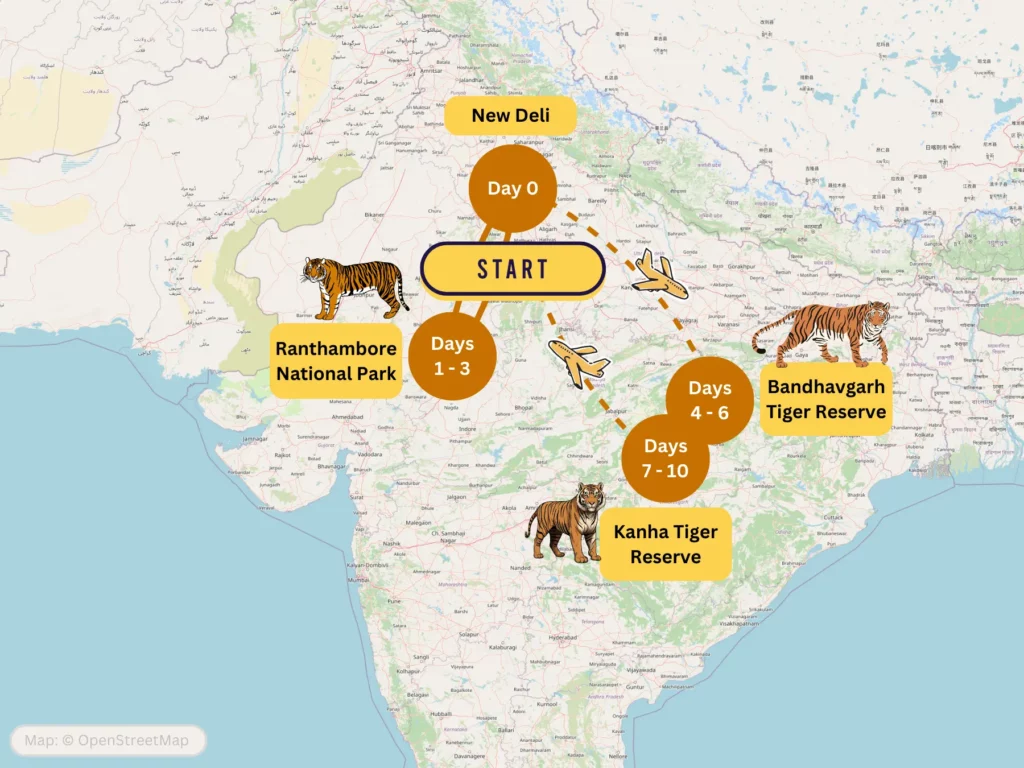
Day By Day Breakdown of Ultimate 10-Day Tiger Safari Itinerary
Day 1: Delhi to Ranthambore Tiger Reserve
Total driving time (excluding game drives): 6 hour drive
Upon arriving in Delhi, you’ll be driven from the airport on a 6 hour scenic drive to Ranthambore Tiger Reserve, where you’ll take your first Indian tiger safari after enjoying a lunch at your lodge.
The high population of tigers in this park gives you a good chance of spotting one or two of its famous cats, and also all the other famous park residents. These include the elusive leopards, sloth bears, striped hyenas, spotted deer, warthogs, crocodiles and tons of monkey and exotic bird species.
Overnight at Ranthambore.
Day 2: Ranthambore Tiger Reserve
Total driving time (excluding game drives): 0 hours
Today you can enjoy 2 game drives, exploring this park’s stunning scenery and its wildlife and hopefully get to see your fair share of tigers. In between drives, you’ll spend the day at your leisure enjoying your lunch and relaxing in the lodge’s grounds.
Day 3: Ranthambore Tiger Reserve to Delhi
Total driving time (excluding game drives): 6 hours
After your last morning game drive at Ranthambore, you’ll drive back to Delhi where you’ll overnight.
Day 4: Delhi to Bandhavgarh Tiger Reserve
Total driving time (excluding game drives): 2 hour flight and 5 hour drive
The entire day will be spent travelling. First a 2 hour flight to Jabalpur followed by a 5 hour drive to Bandhavgarh Tiger Reserve, another of India’s premier national parks arriving in time for dinner.
Overnight at Bandhavgarh.
Day 5 – 6: Bandhavgarh Tiger Reserve
Total driving time (excluding game drives): 0 hours
The next two days will be spent going on safari in an open Jeep exploring the core zones of the park in search of some of its many tigers, passing through various landscapes of grasslands, forests and swamps, all perfect habitats for these elusive cats.
Other animals you’ll come across include leopards, sloth bears, Indian bison, Indian wolves, warthogs, deer and hundreds of bird species.
While looking for birds in the dense forests, keep an eye out for any of the park’s famous flying squirrels which parachute from time to time from the tree tops. How these fragile looking characters don’t break any limbs is beyond belief.
Overnight at Bandhavgarh.
Day 7: Bandhavgarh to Kanha Tiger Reserve
Total driving time (excluding game drives): 5 hours
After returning to your lodge from your morning game drive and hopefully having spotted enough tigers, you set off on a 5 hour drive to Kanha Tiger Reserve, where you’ll spend the night.
Day 8 – 9: Kanha Tiger Reserve
Total driving time (excluding game drives): 0 hours
The next two days will be taken up going on 2 daily game drives exploring this reserve where you’ll most likely meet up with a few tigers and the many other animals as well as enjoying its serene and varied landscape.
You’ll be passing through open grasslands, forests, rivers, streams and swamps, ideal habitats for tigers, leopards, striped hyenas, Indian bison, warthogs and for the thousands of deer that form the prime food source for all the big cats and other predators.
The afternoon game drive on day 9 will be your last safari in India, hopefully having enjoyed seeing enough tigers and other wildlife species to your heart’s content.
Day 10: Kanha Tiger Reserve to Delhi
Total driving time (excluding game drives): 6 hour drive followed by 2 hour flight
Today you say goodbye to Kanha as you spend your final day in transit. Starting off in the morning with a 6 hour drive to Jabalpur Airport, followed by a 2 hour flight to Delhi.
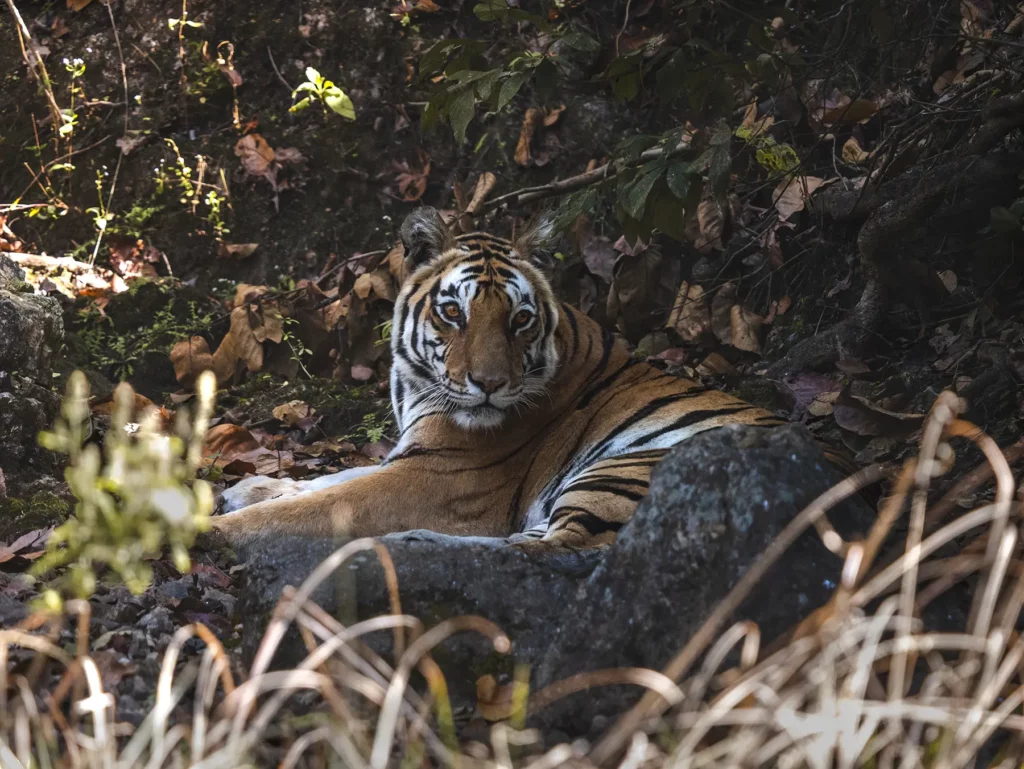
Recommended Booking Options For Your India Tiger Safari Itinerary
Safari with local tour operator
Most popular & best experience – typical prices for this itinerary start from $400 per person per day.
Visit safarisbyella.com for free quotes from trustworthy local tour companies I use to book my own trips.

Final Thoughts
Although tiger safaris in India are not regarded as cheap, they are certainly memorable, leaving permanent impressions on everyone fortunate enough to have gone on one.
Seeing even just one of these majestic cats wandering around in the wild is worth the entire trip and effort.
But let’s not just be obsessed with tigers and forget to appreciate the numerous other spectacular species of animals and birds and even more so, the natural splendour of India.
Yes, knowing which park to choose, when to go and with whom you book your trip, may be daunting, but by finding an experienced local tour operator who will advise you correctly and take care of all your travel logistics, will enable you to just sit back and enjoy your tiger safari adventure in India.
I hope I have given you some food for thought, and hopefully have ignited a little spark within you to visit this mysterious and exotic land and see these endangered and beautiful cats in the wild, which is the only place they should ever be seen in.

Literally you are a Brave and great experienced woman
Wow…This is vert detailed and useful.
I have not seen such an extensively detailed article on this topic. congratulations to you. Some the parks you have mentioned, i have been to. The sightings in Sundarbacns have increased recently and its unlike any other parks in India. Here the importance of an experienced tracker is paramount. As you have mentioned the best time to visit is between Oct to April , its probably true weatherwise but tiger sightings are more during the summer ( May- June).
the graph showing chance of sightings is interesting, my two cents is, as the whole area is not open to tourism, tiger density of a park is not everything, various other factors are also important ( open space, location water bodies, time of the year etc). Presently although all the parks boast of significant sightings, Tadoba leads the pack. Thanks once again for all the hard research works and making this website, its very useful even to us resident Indians.